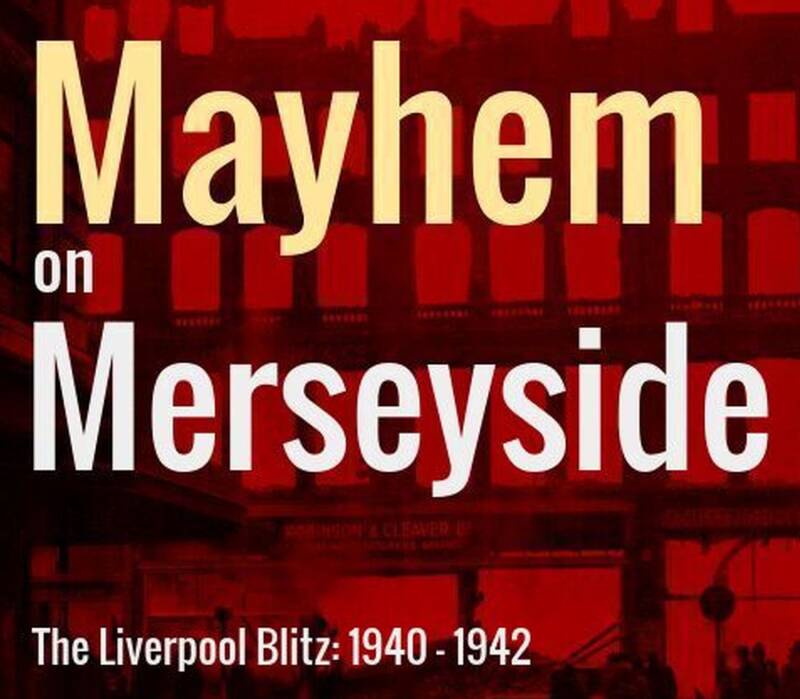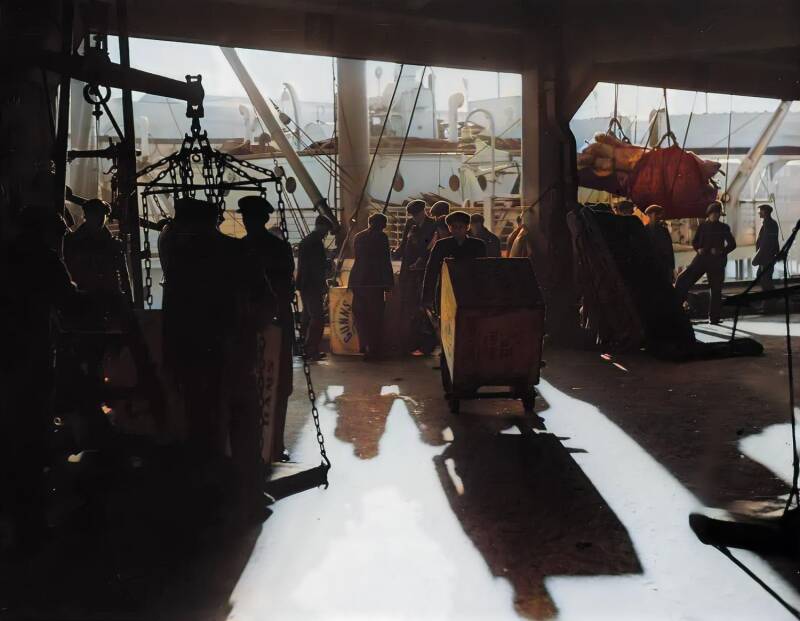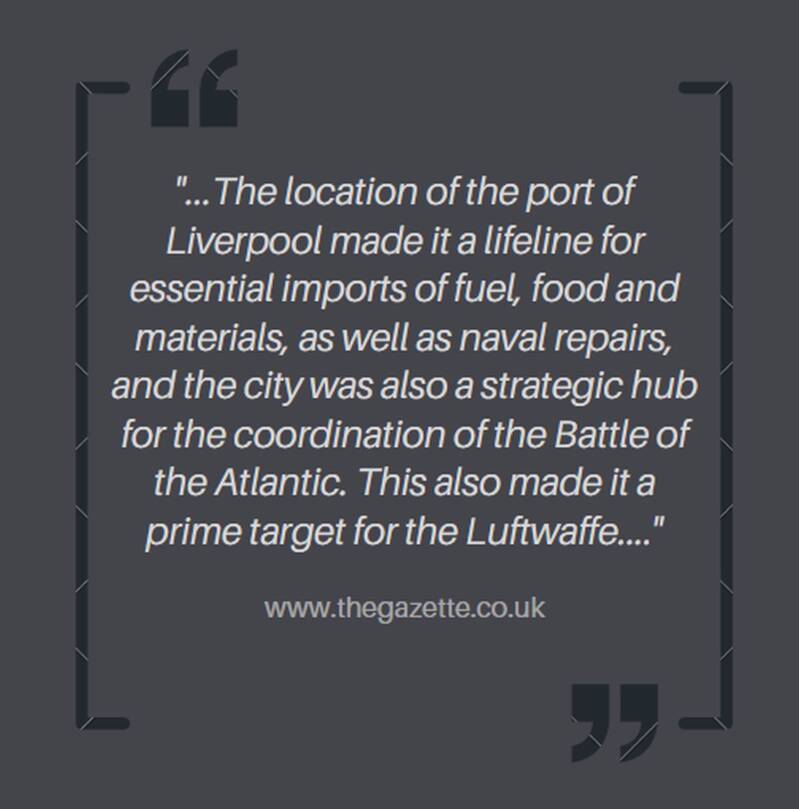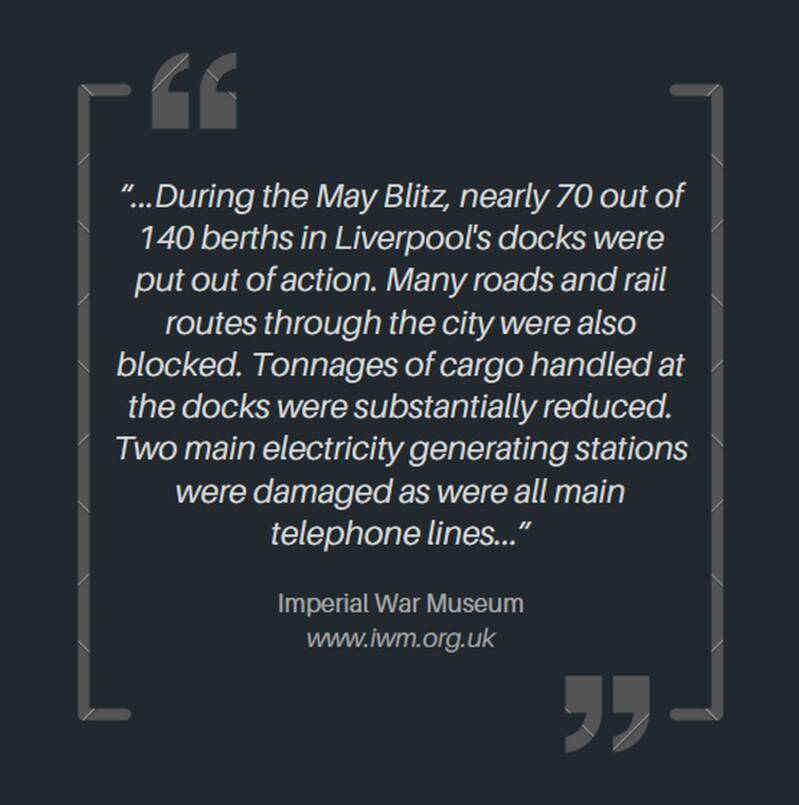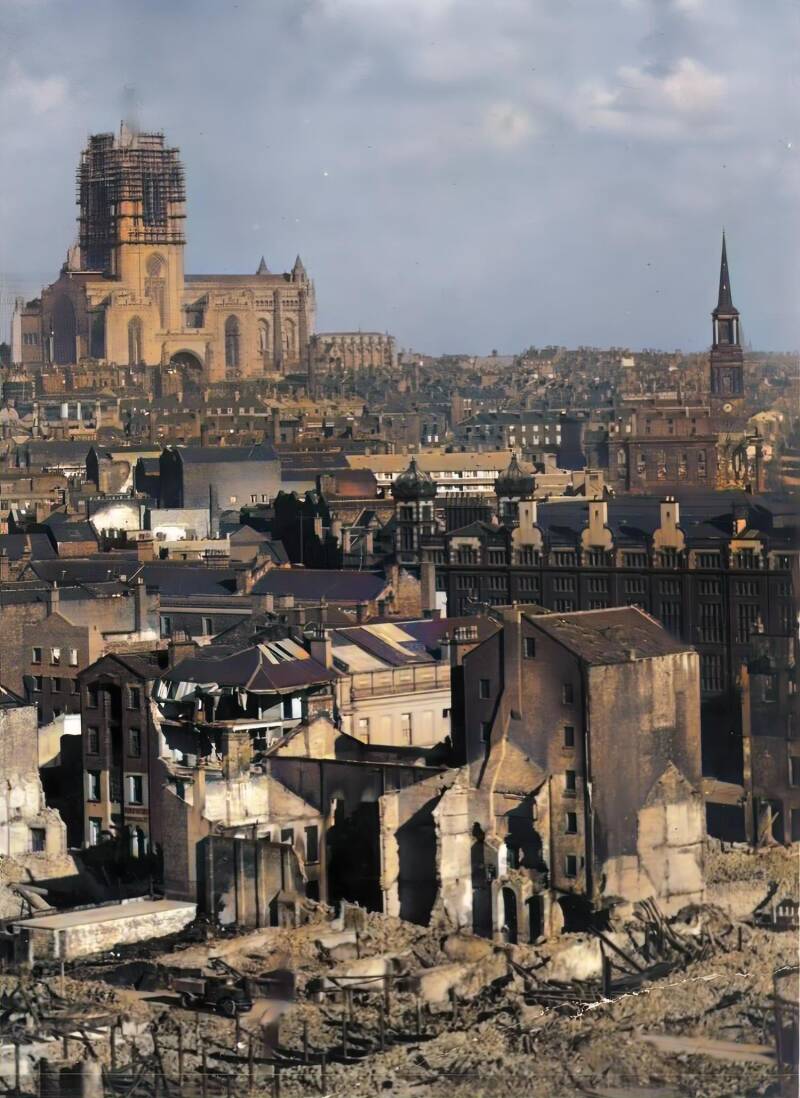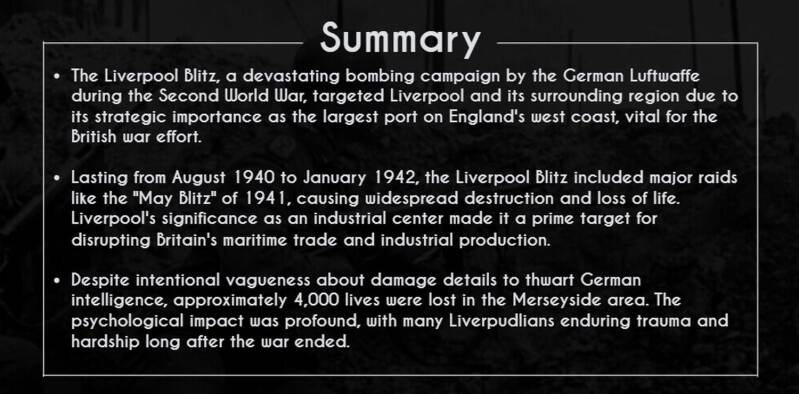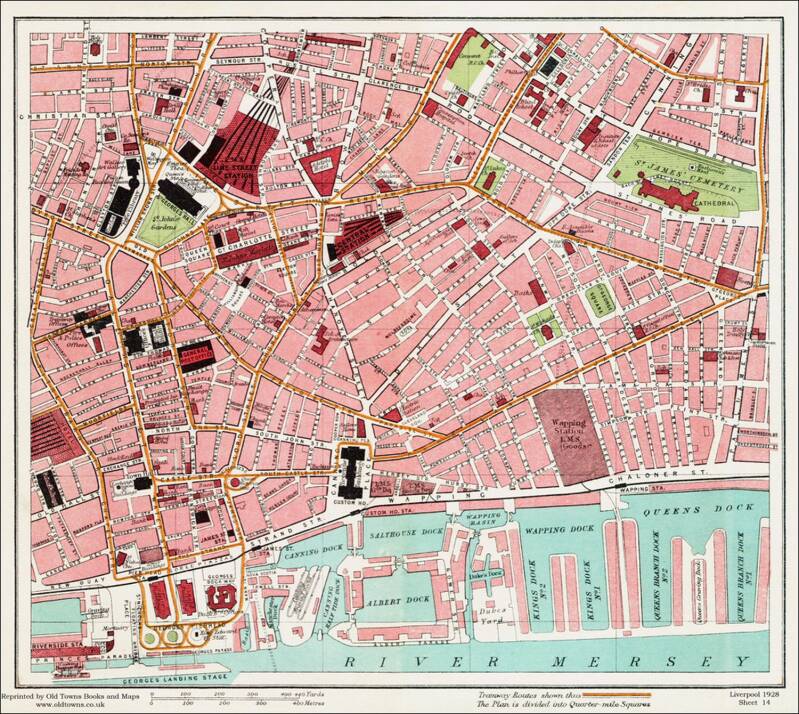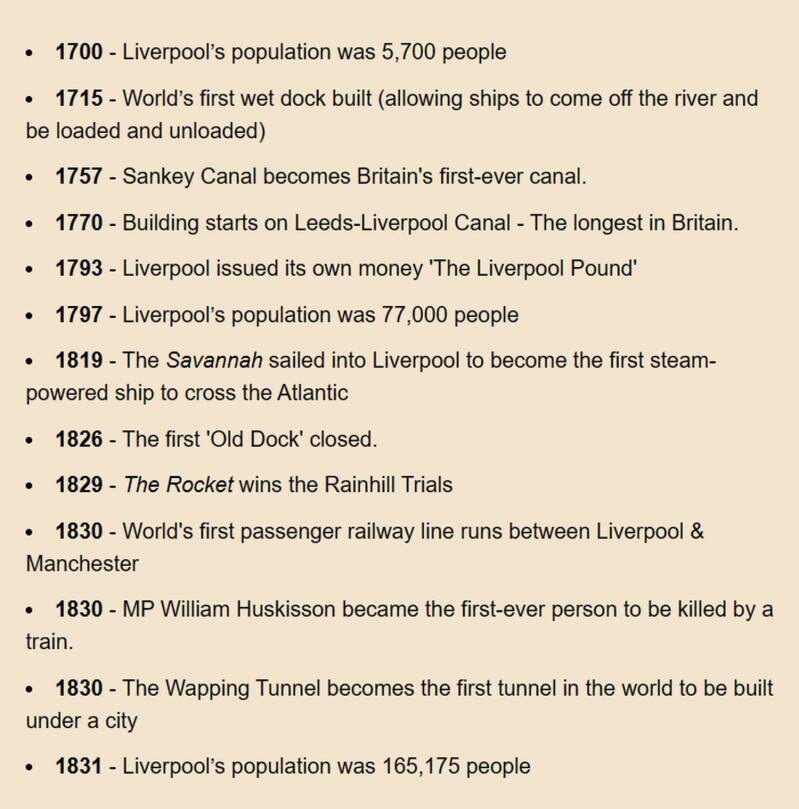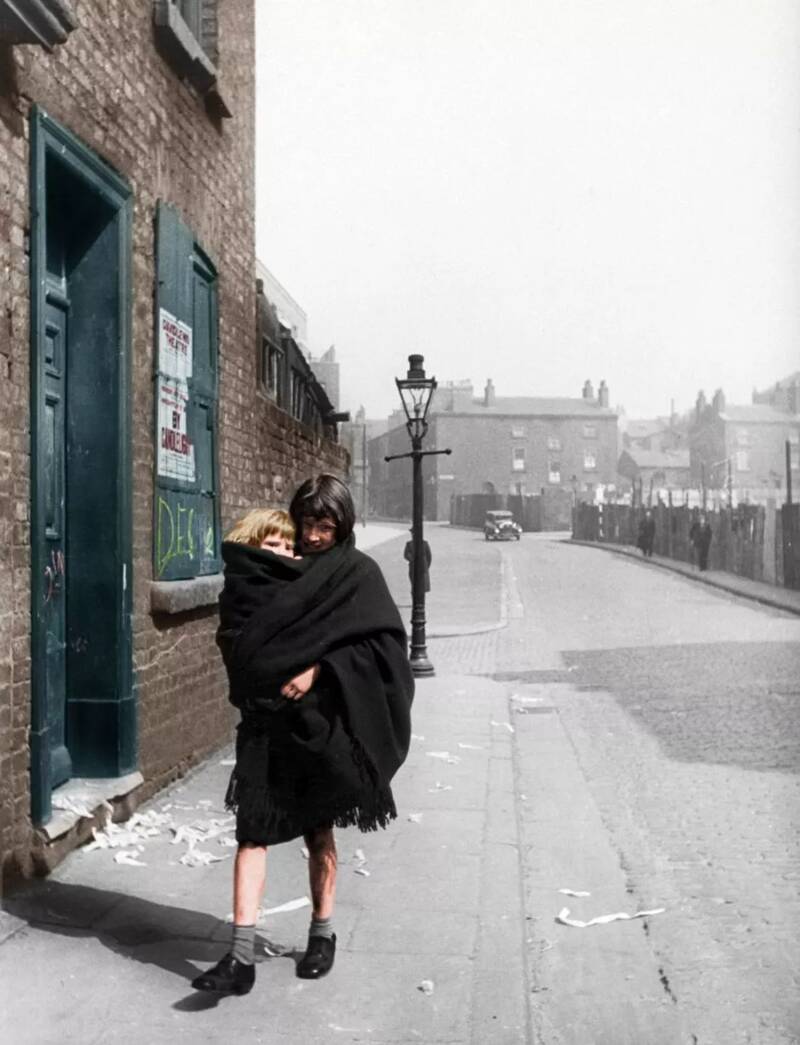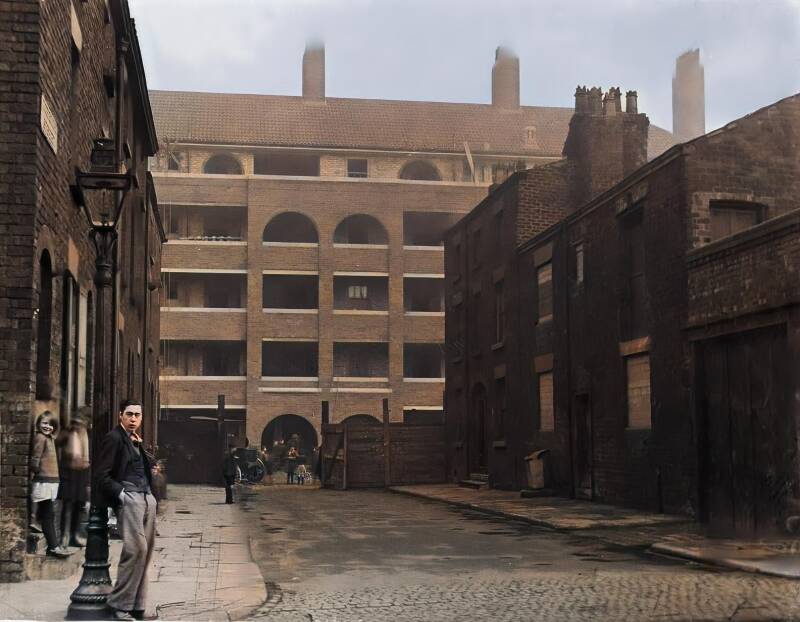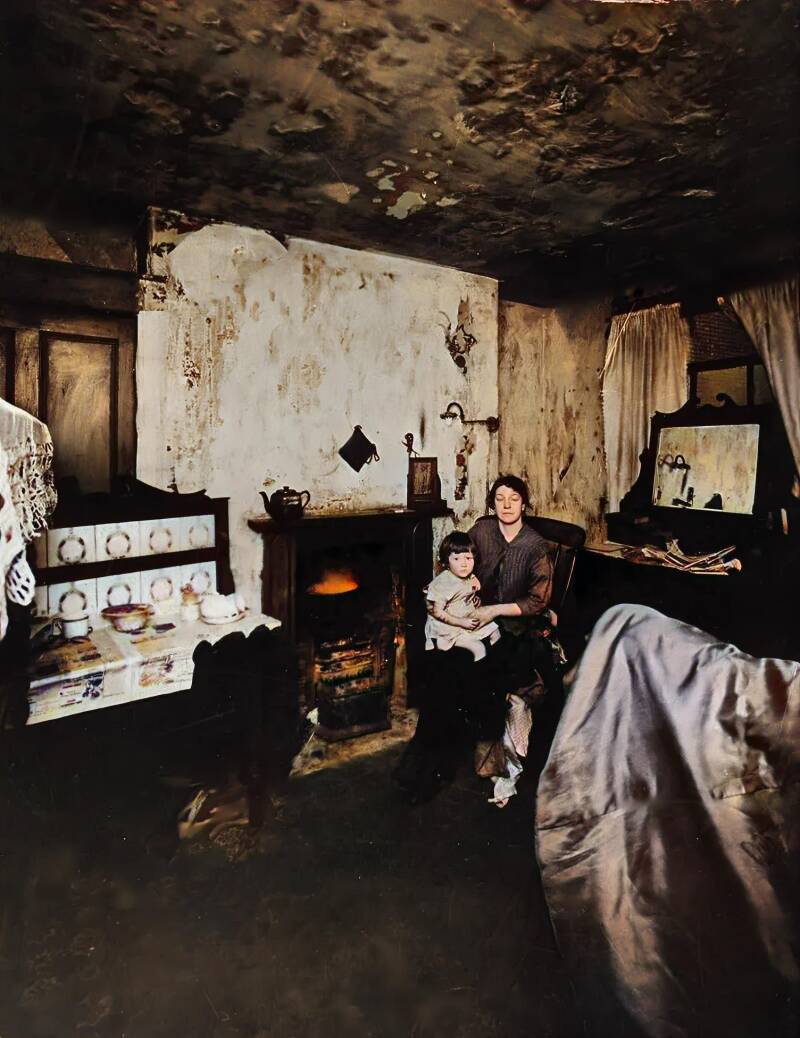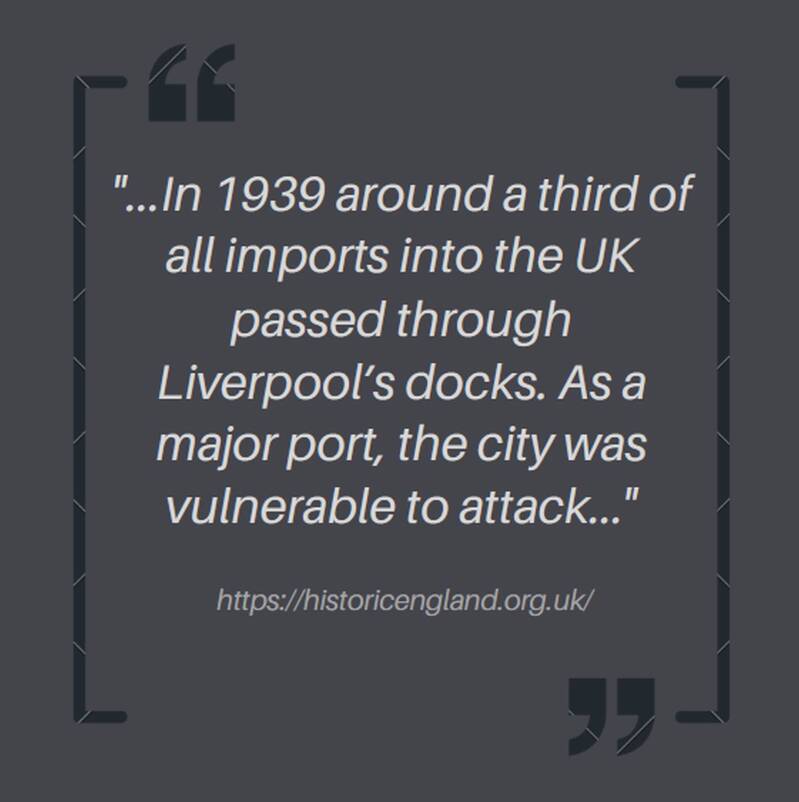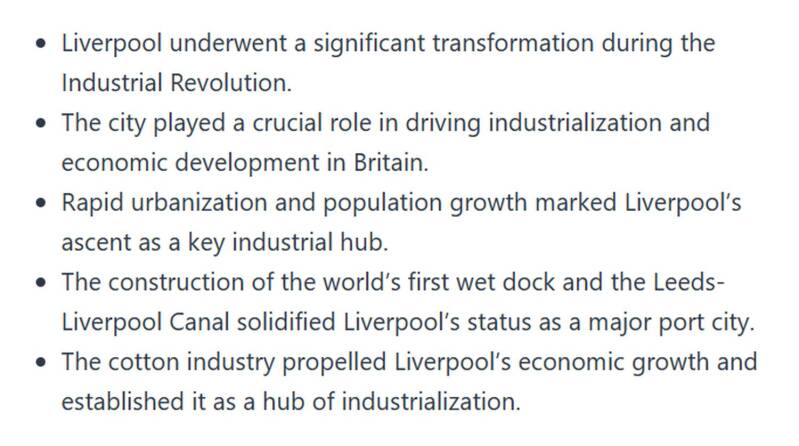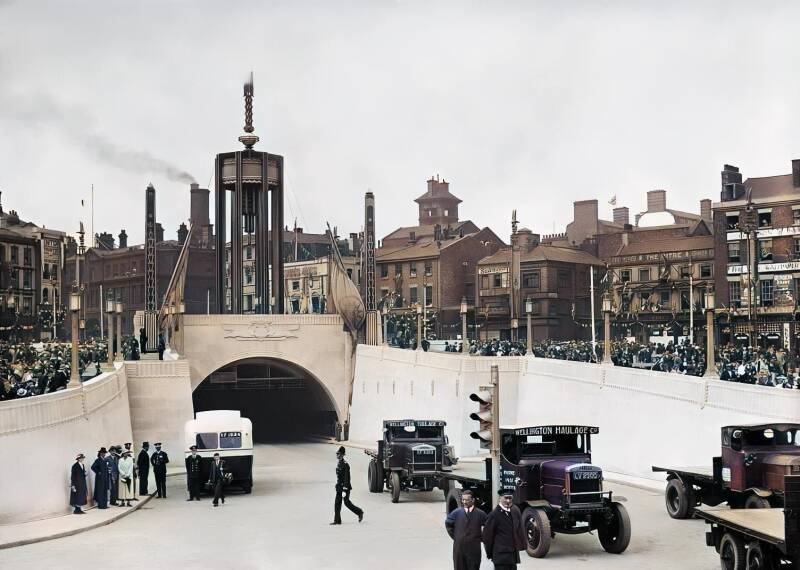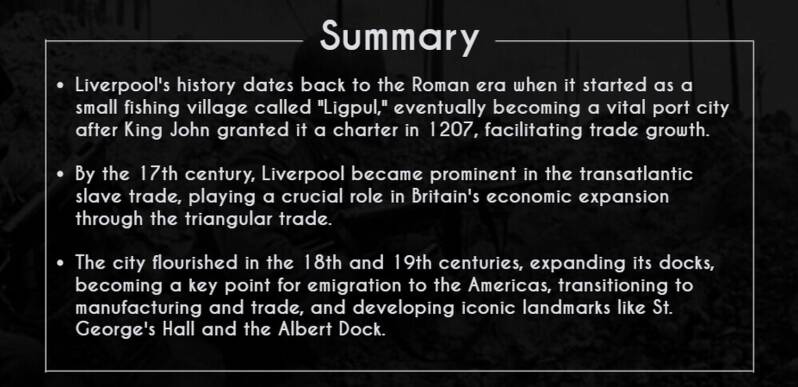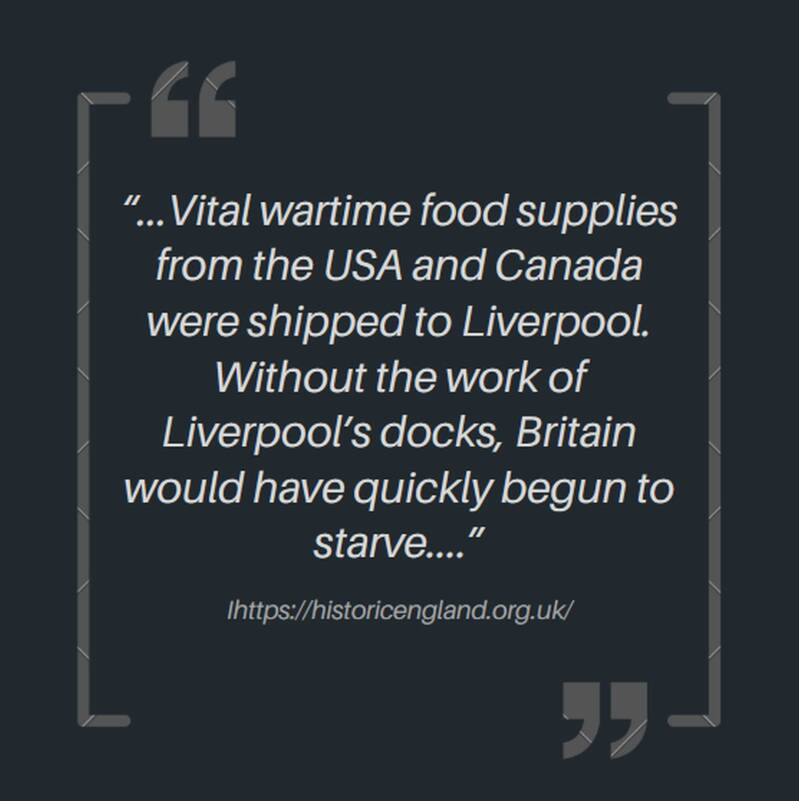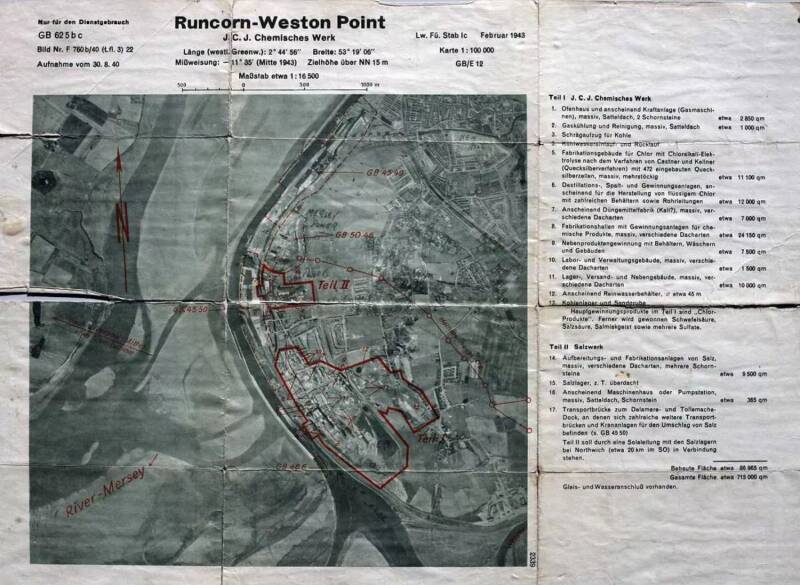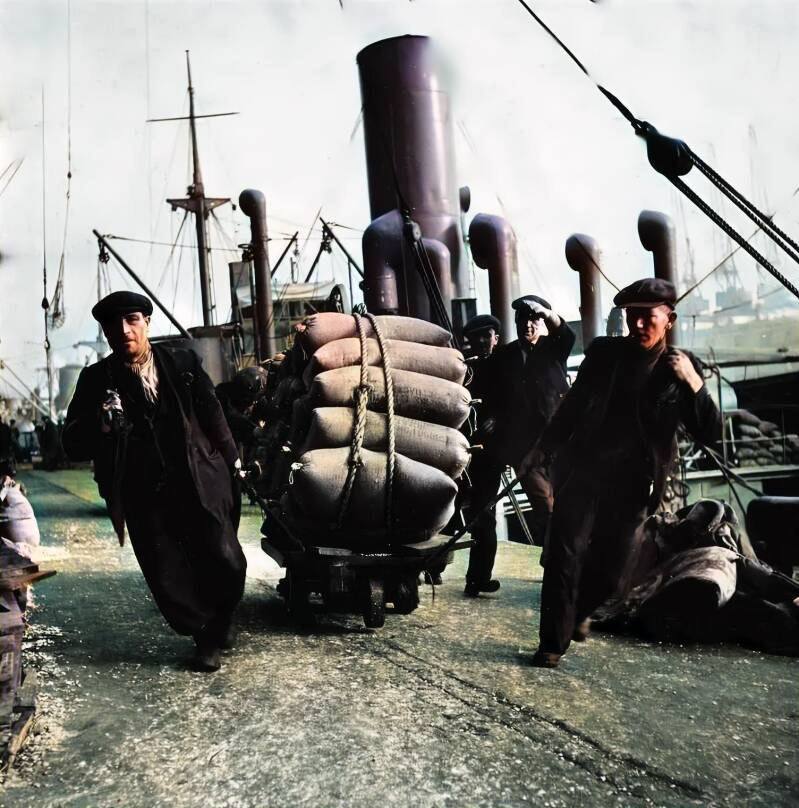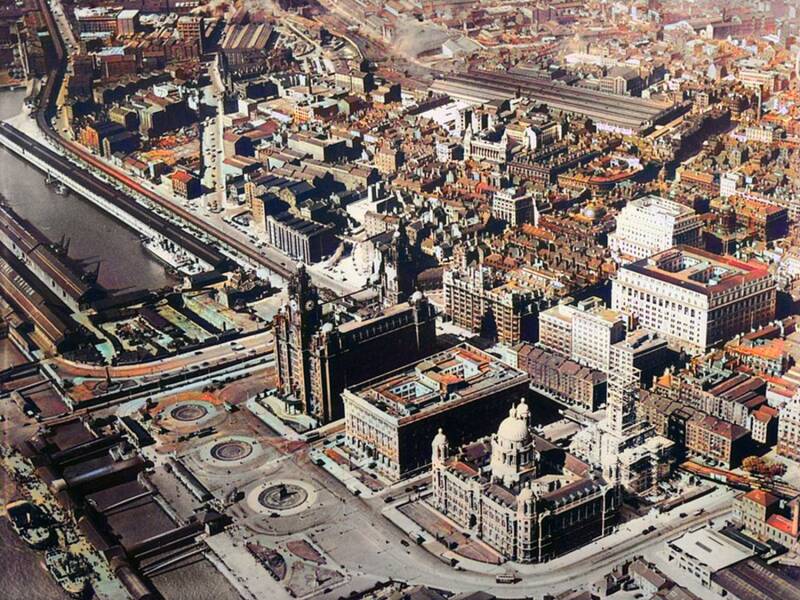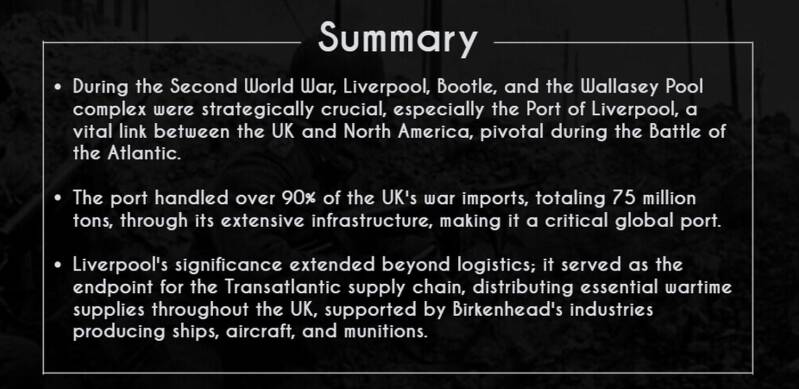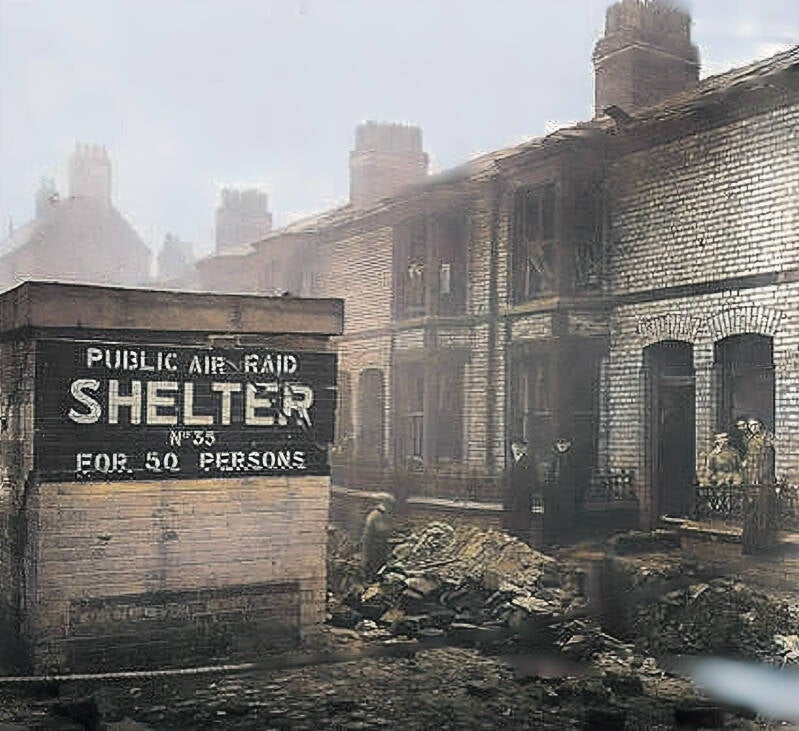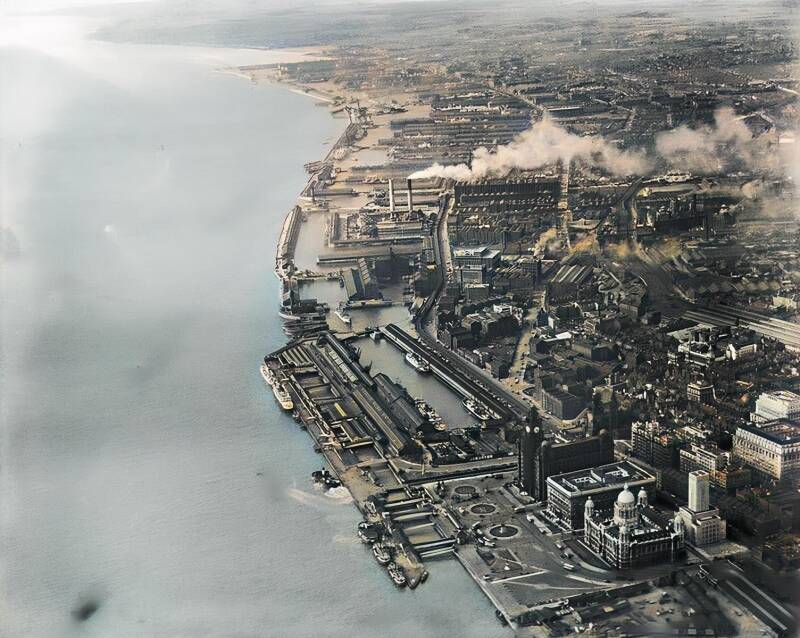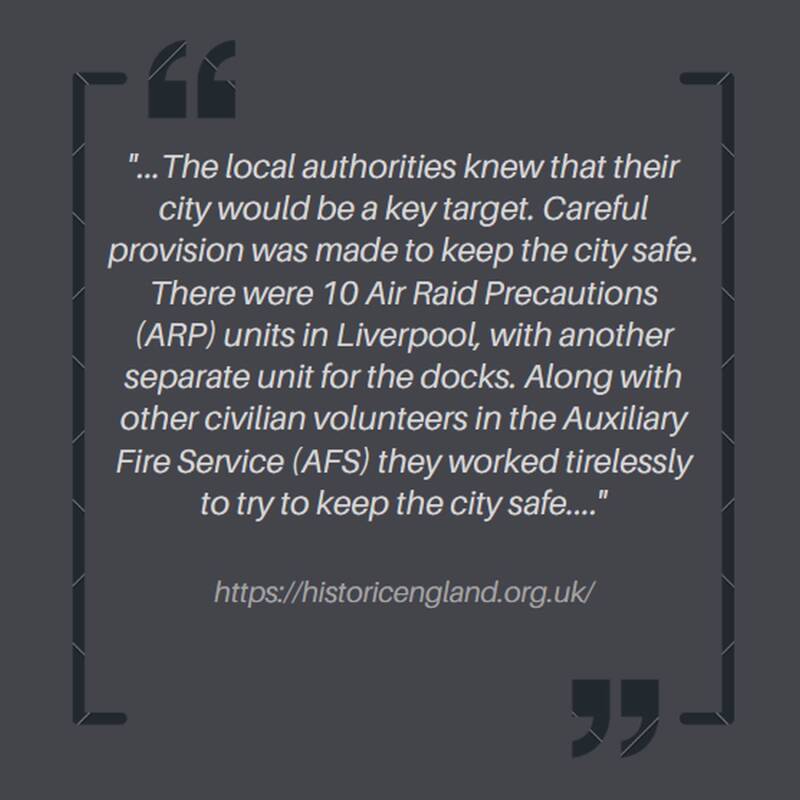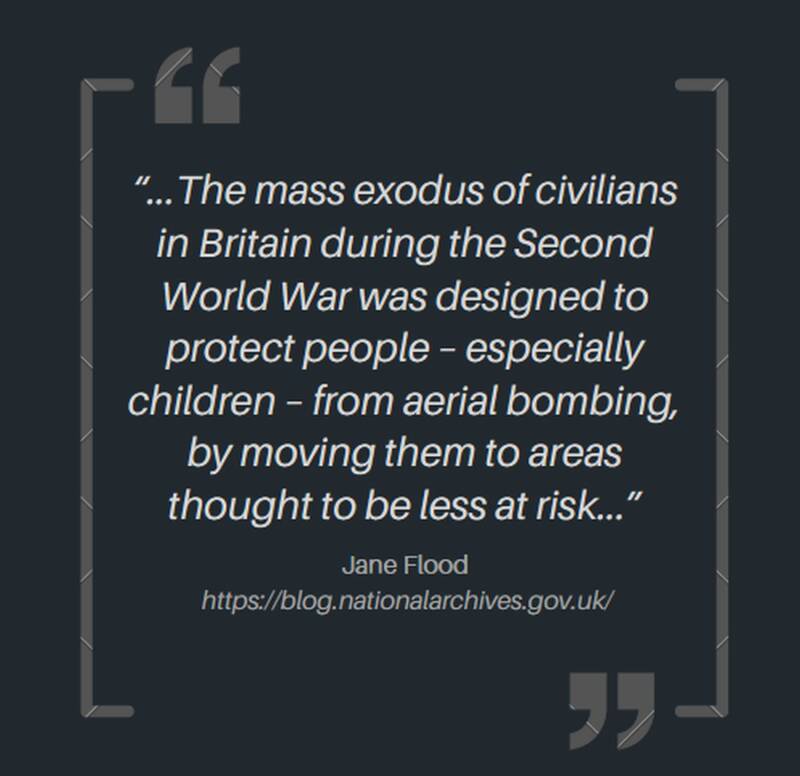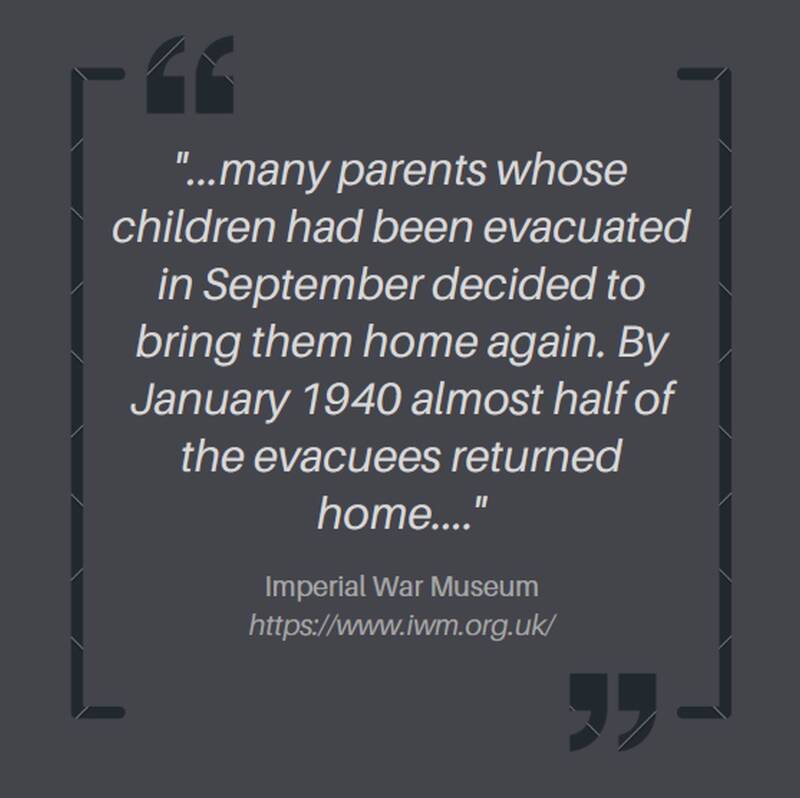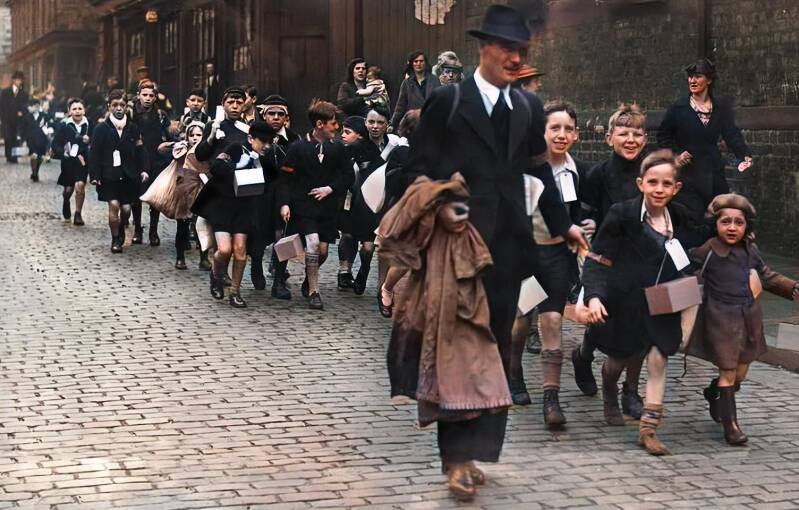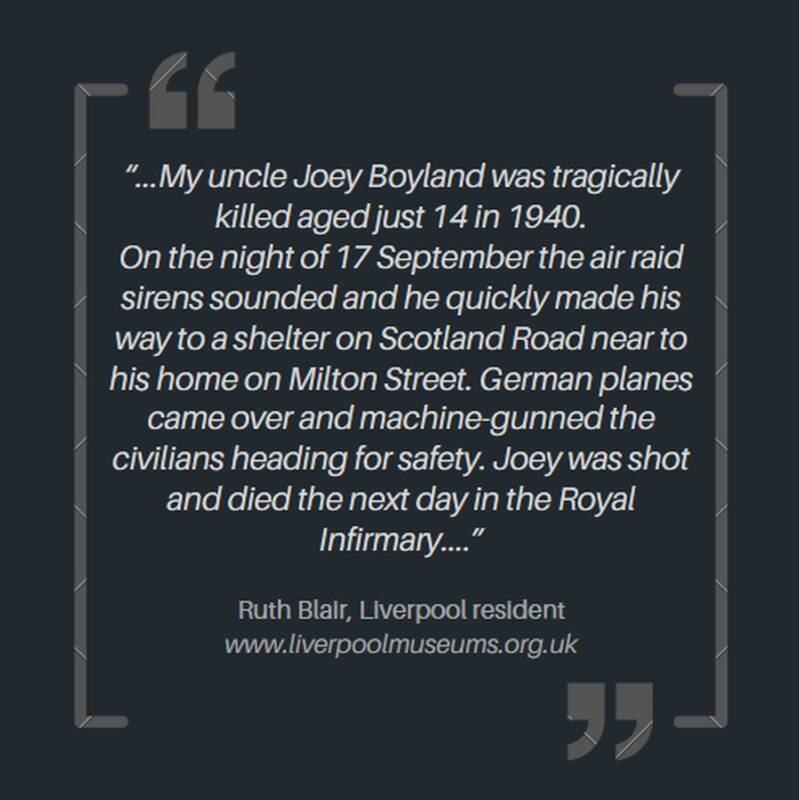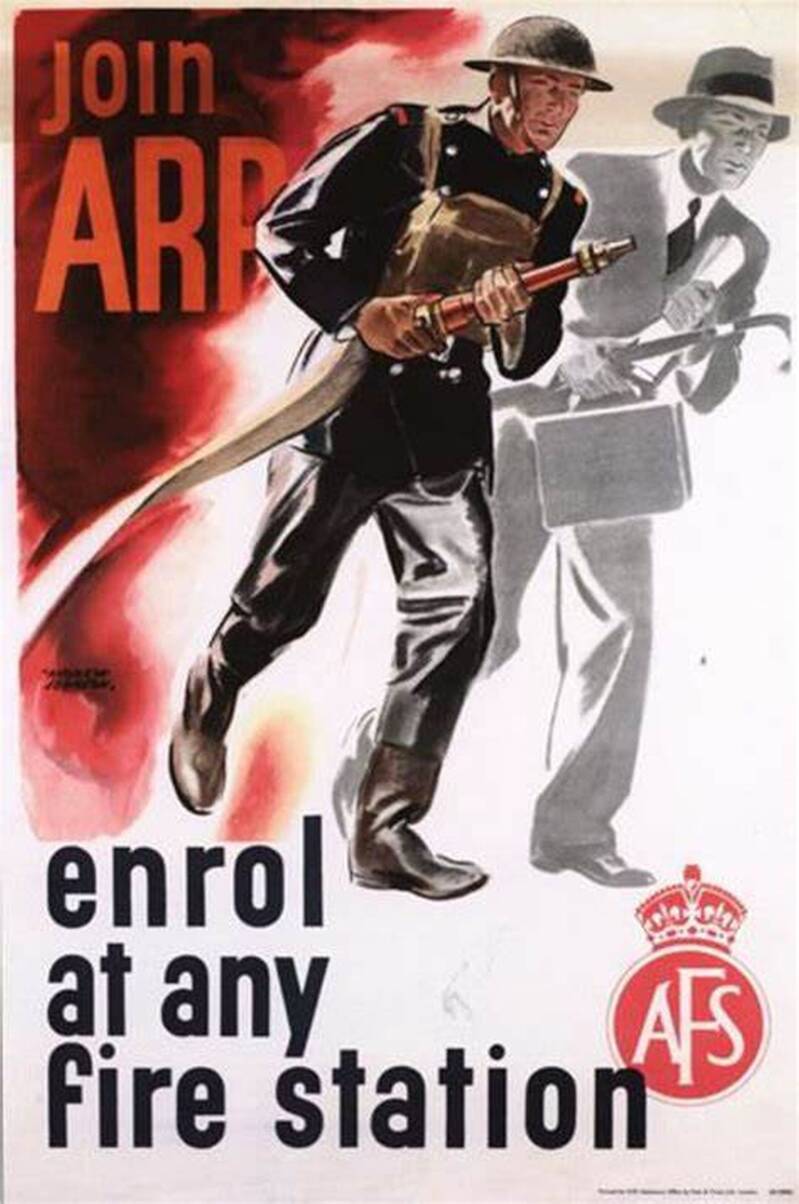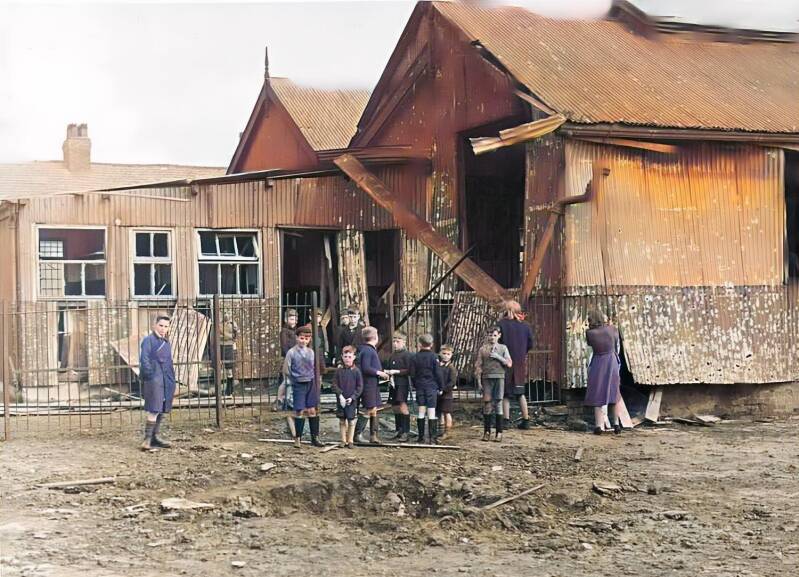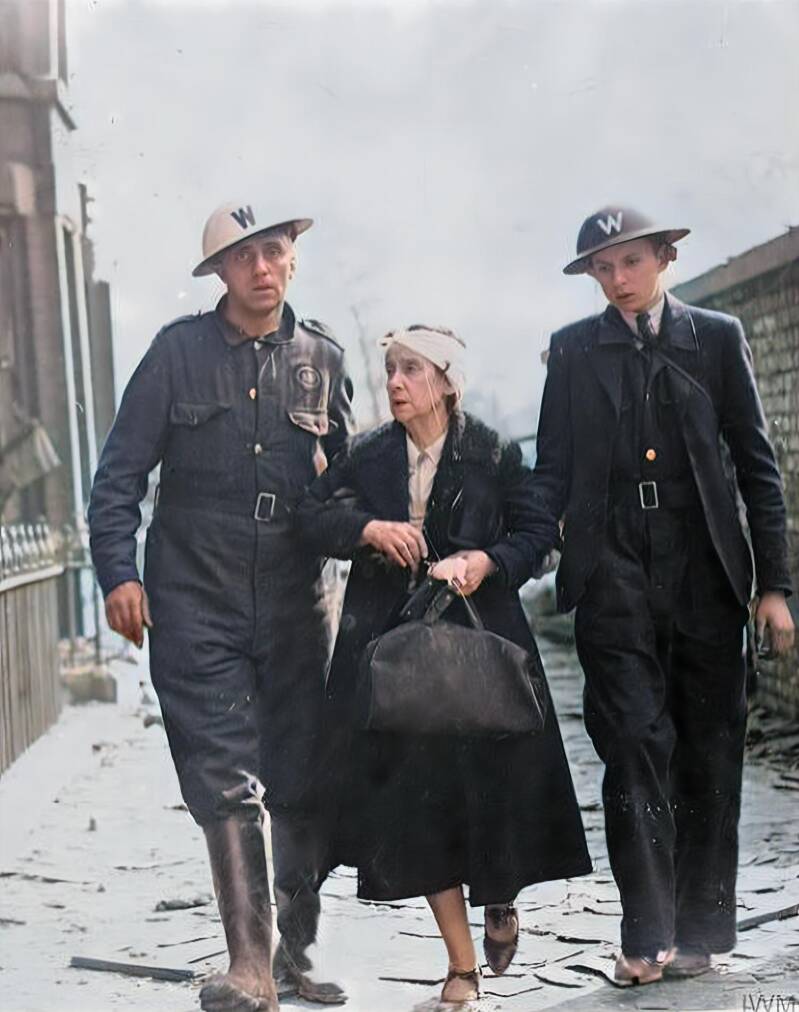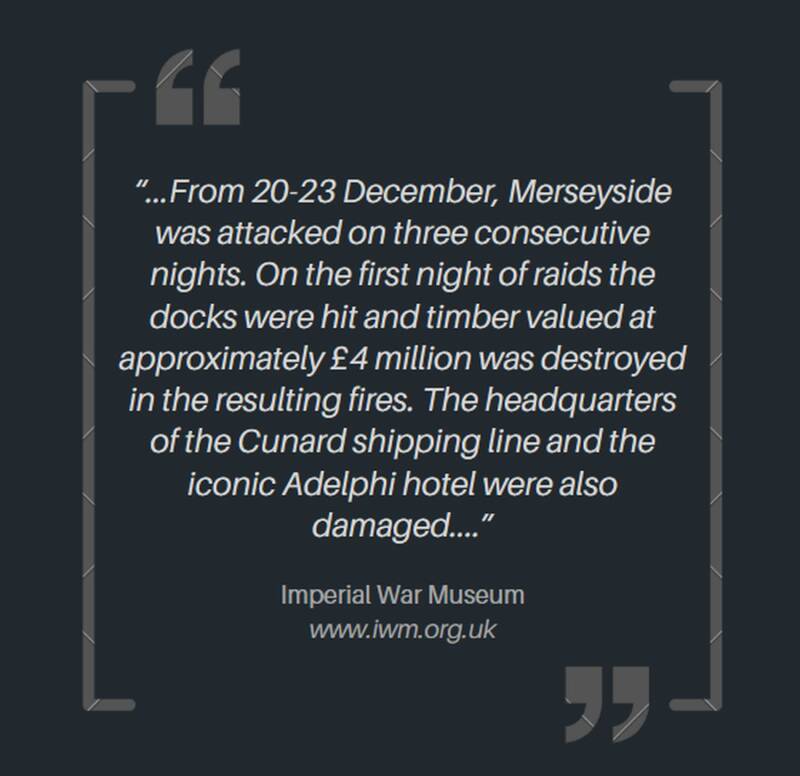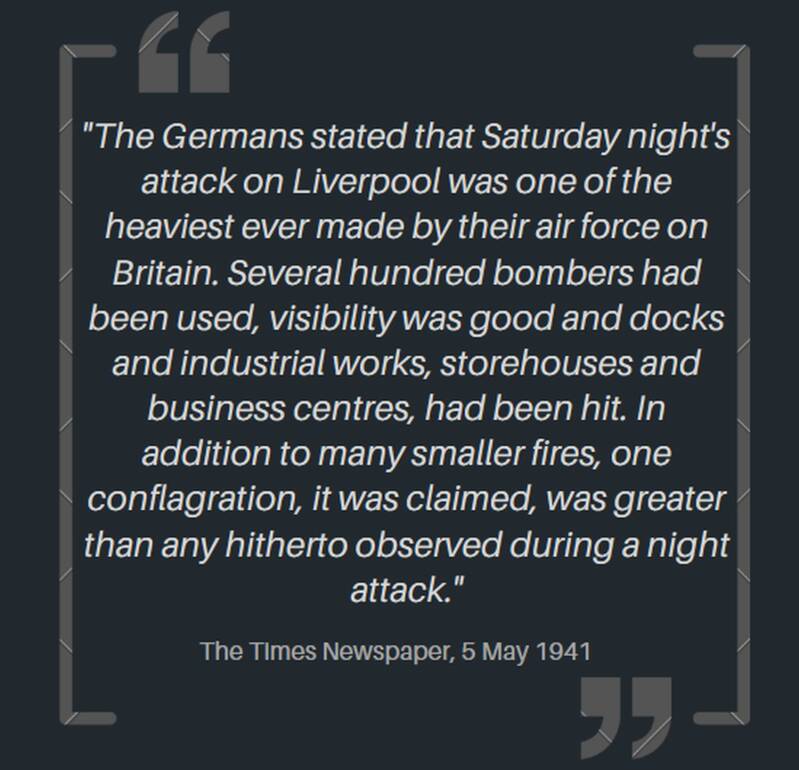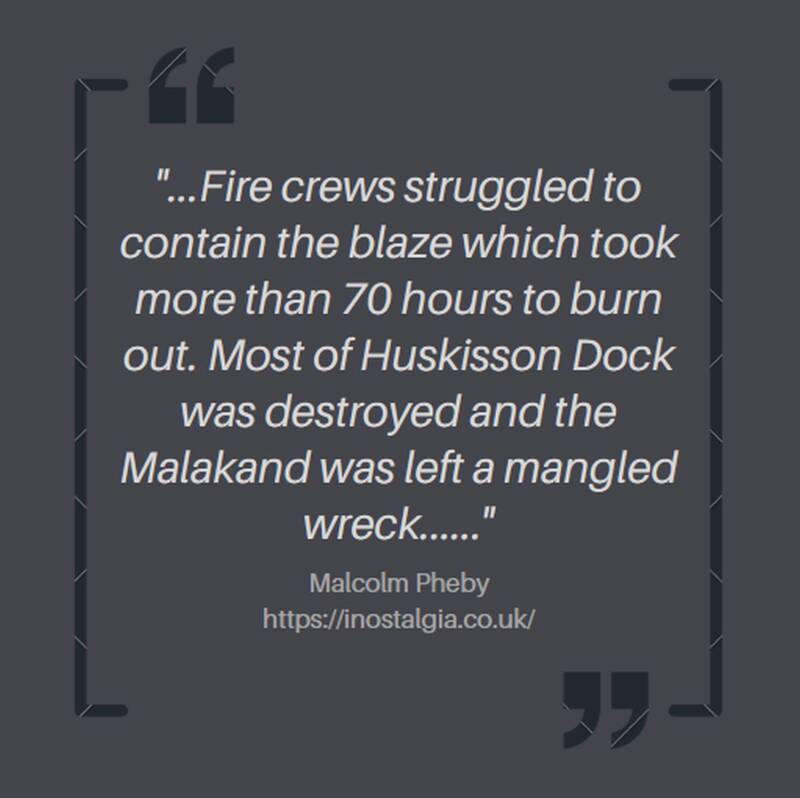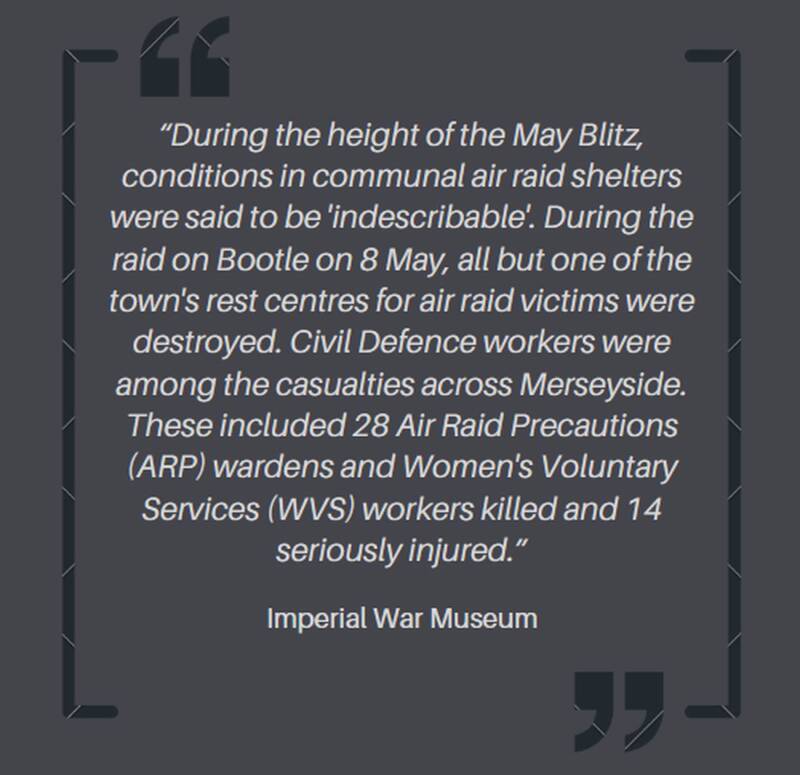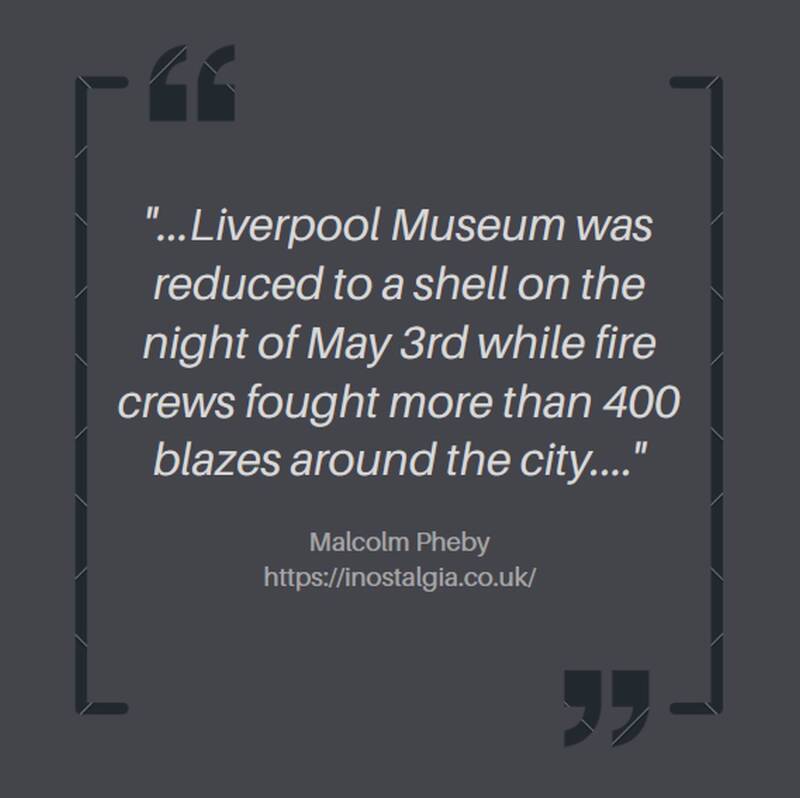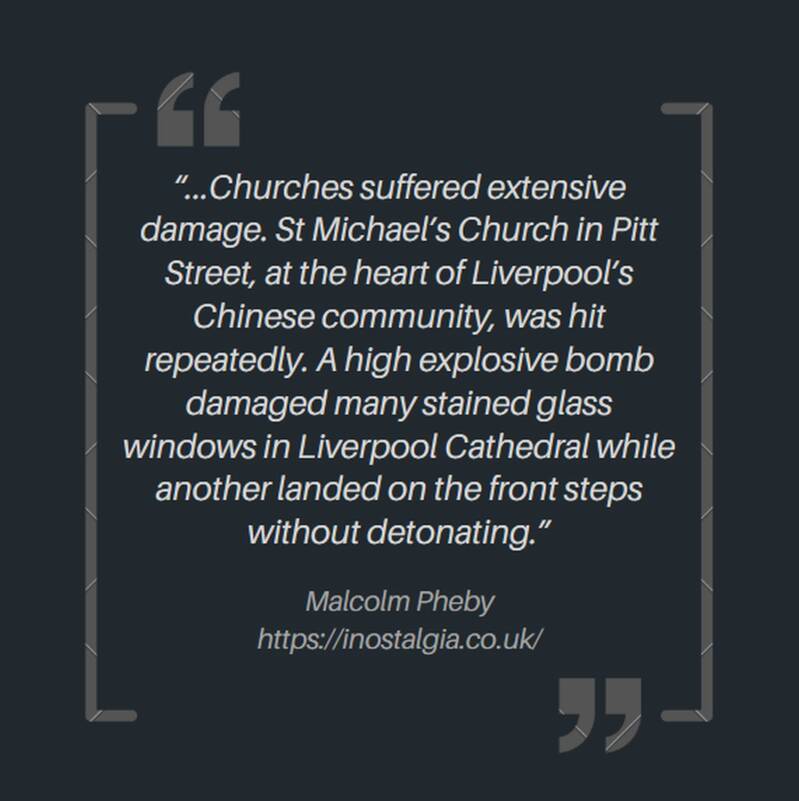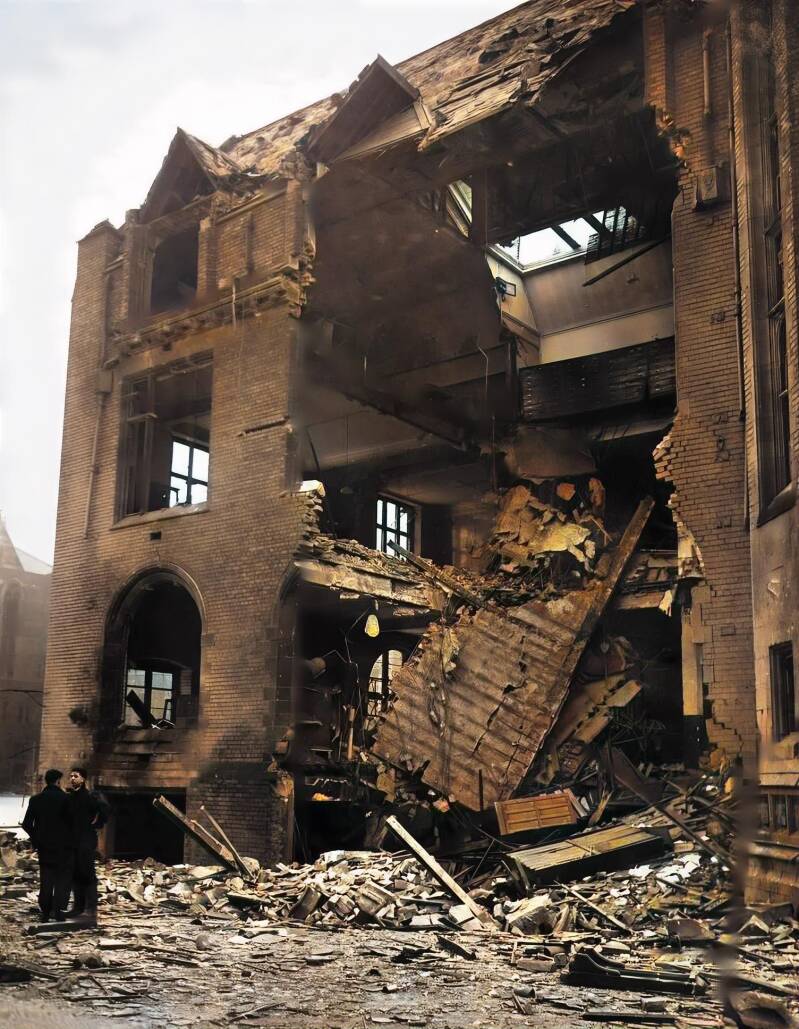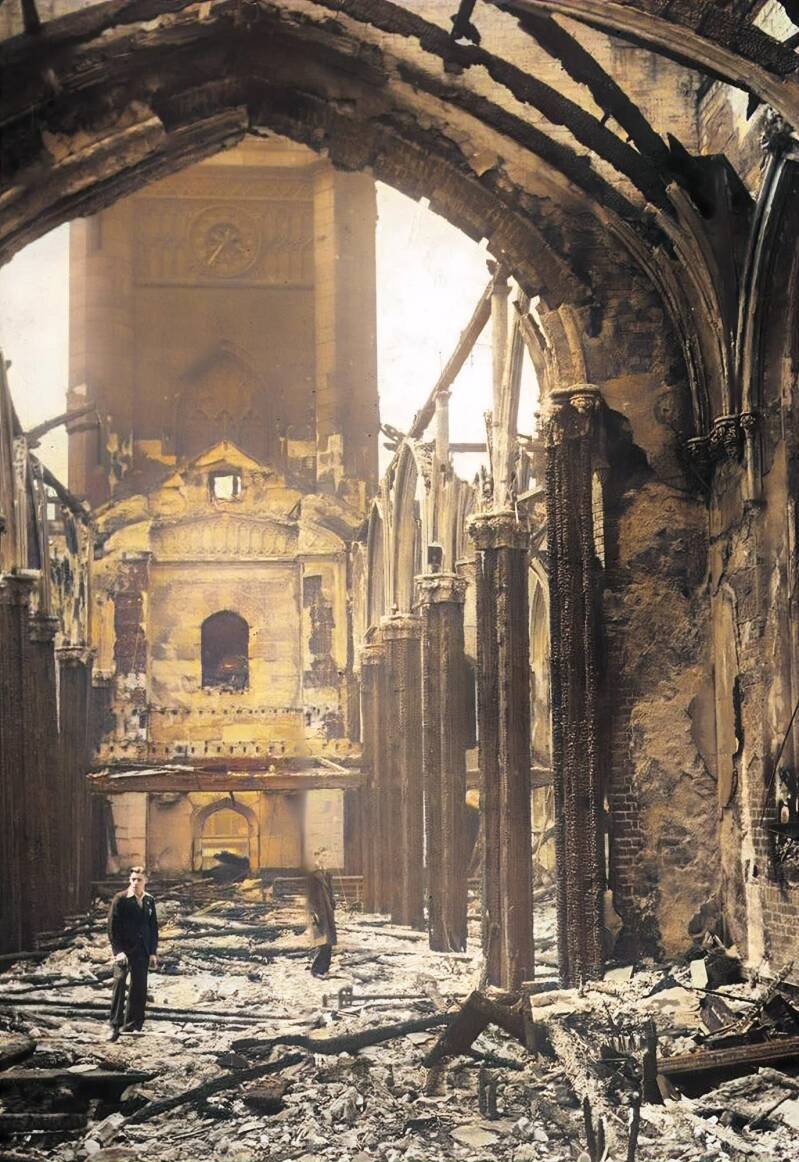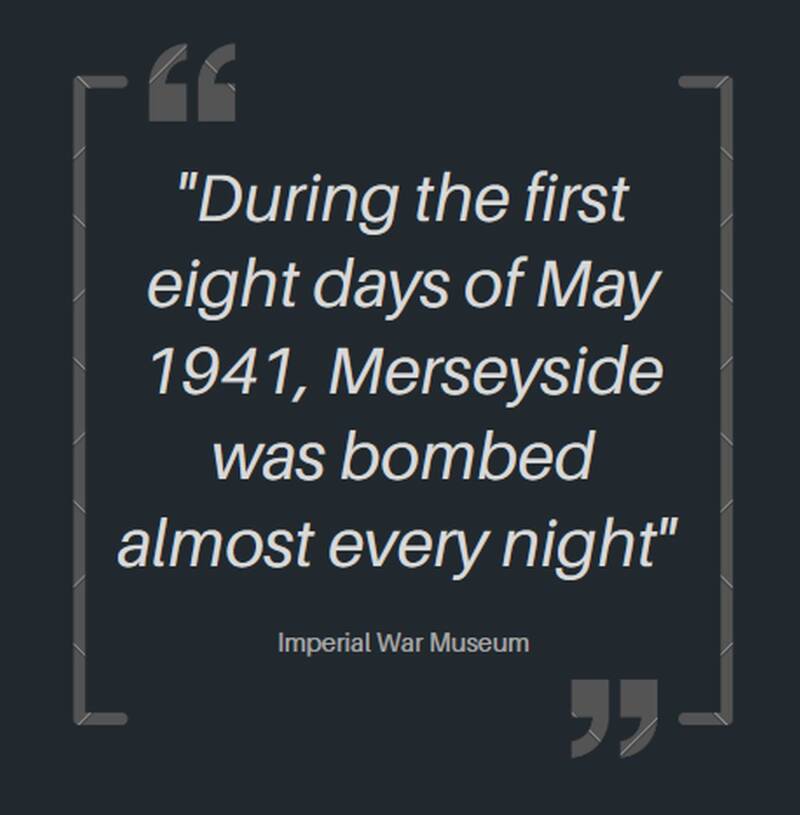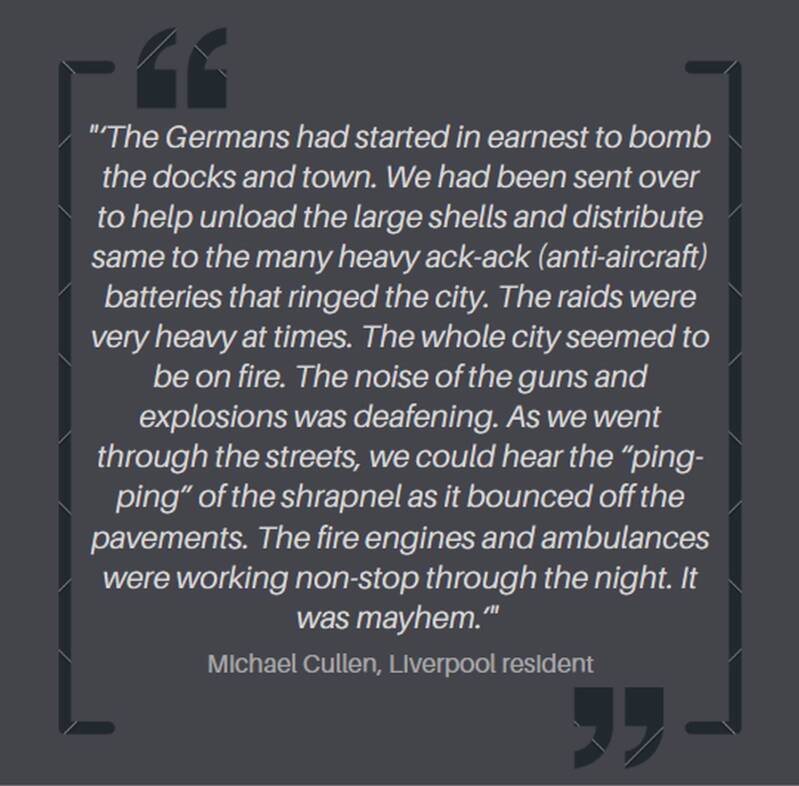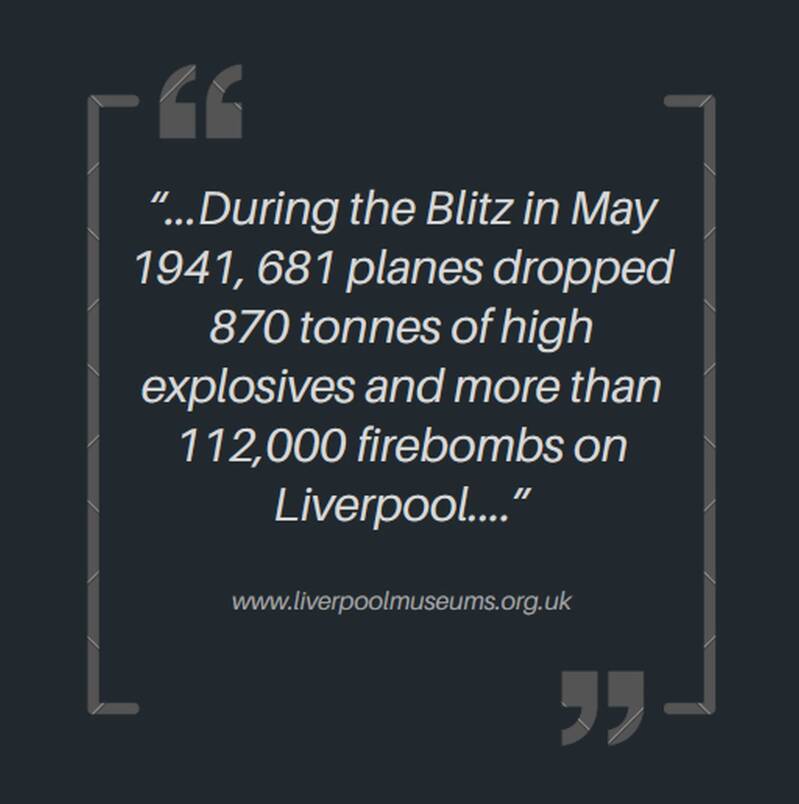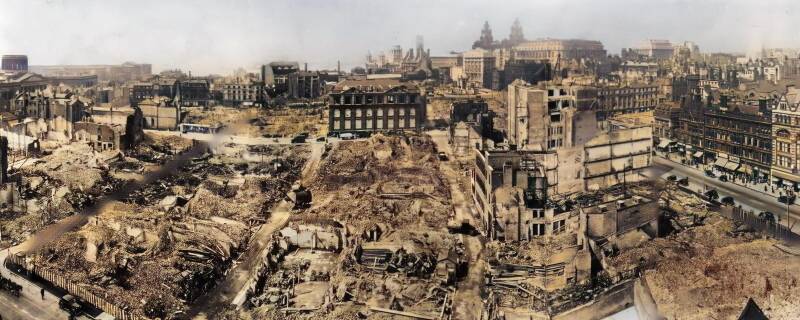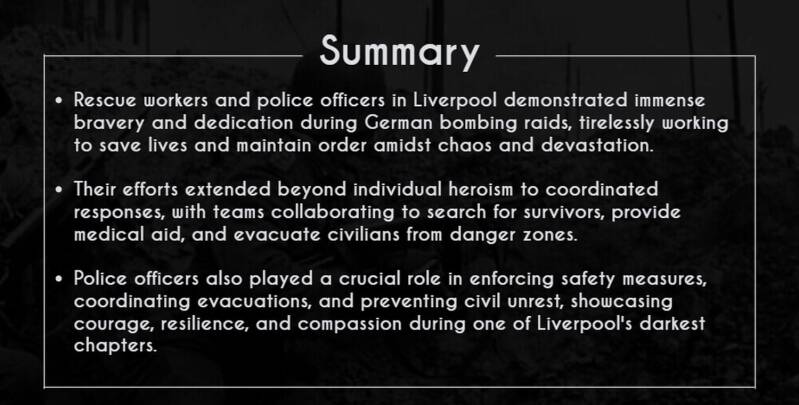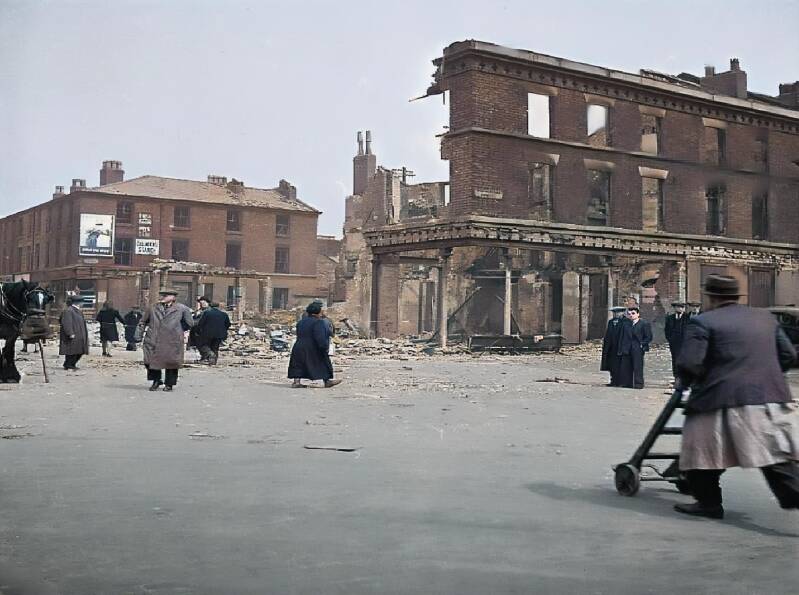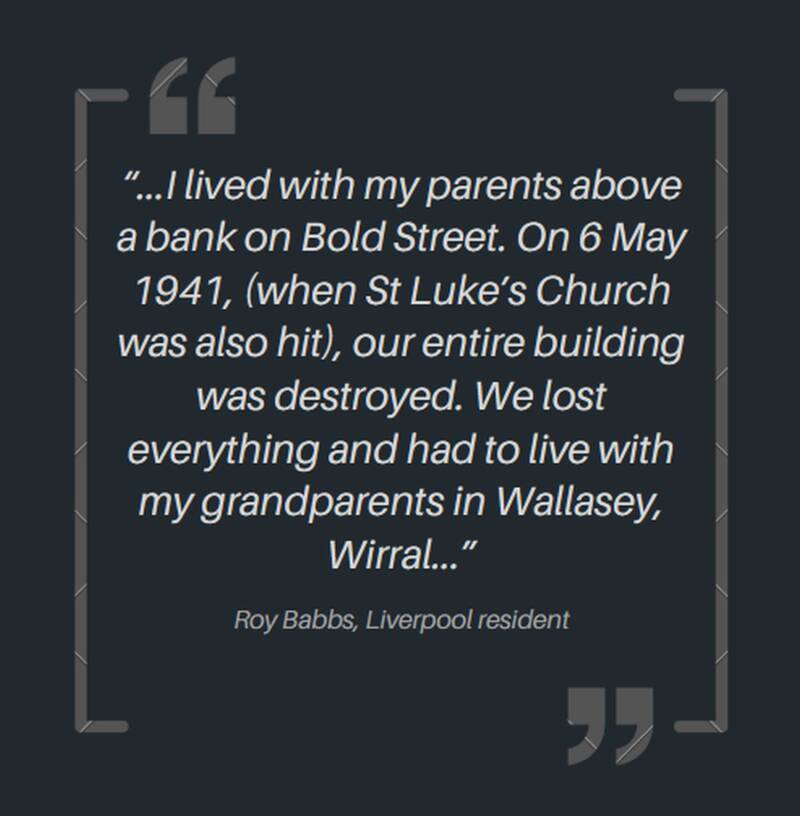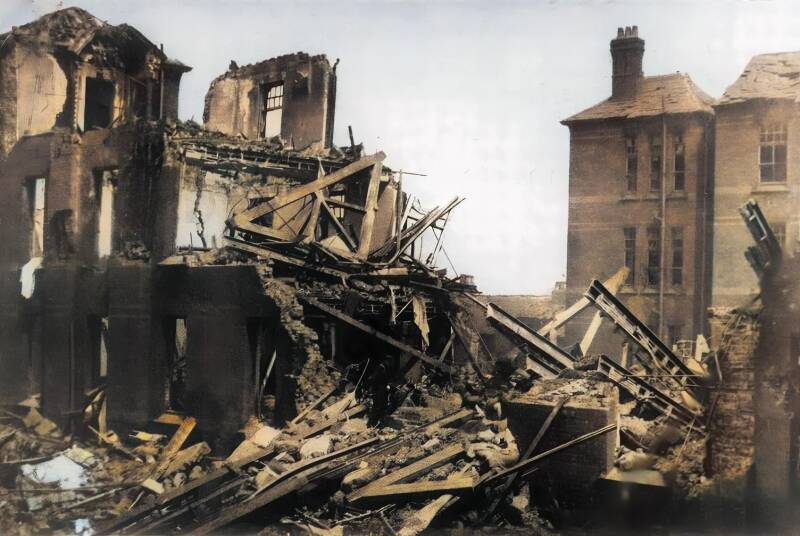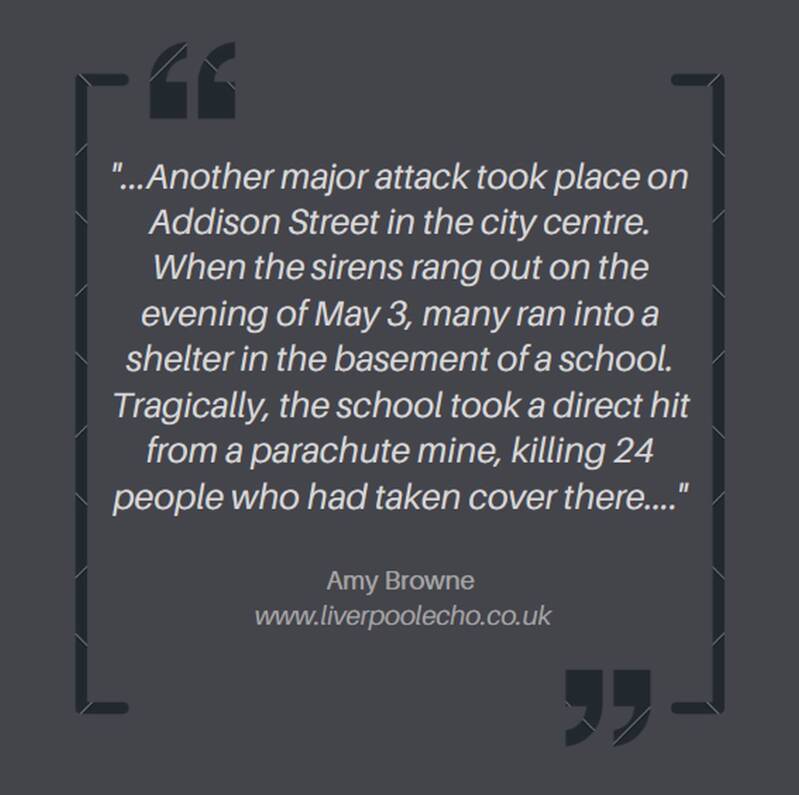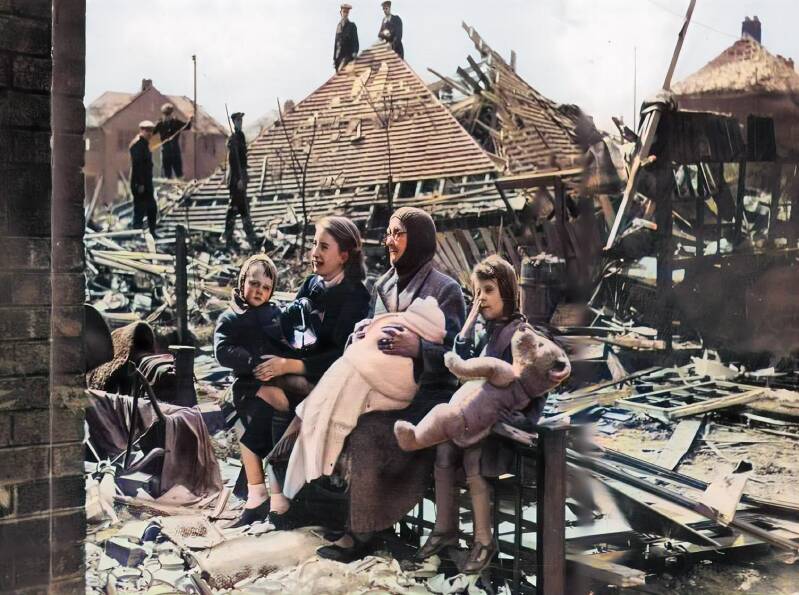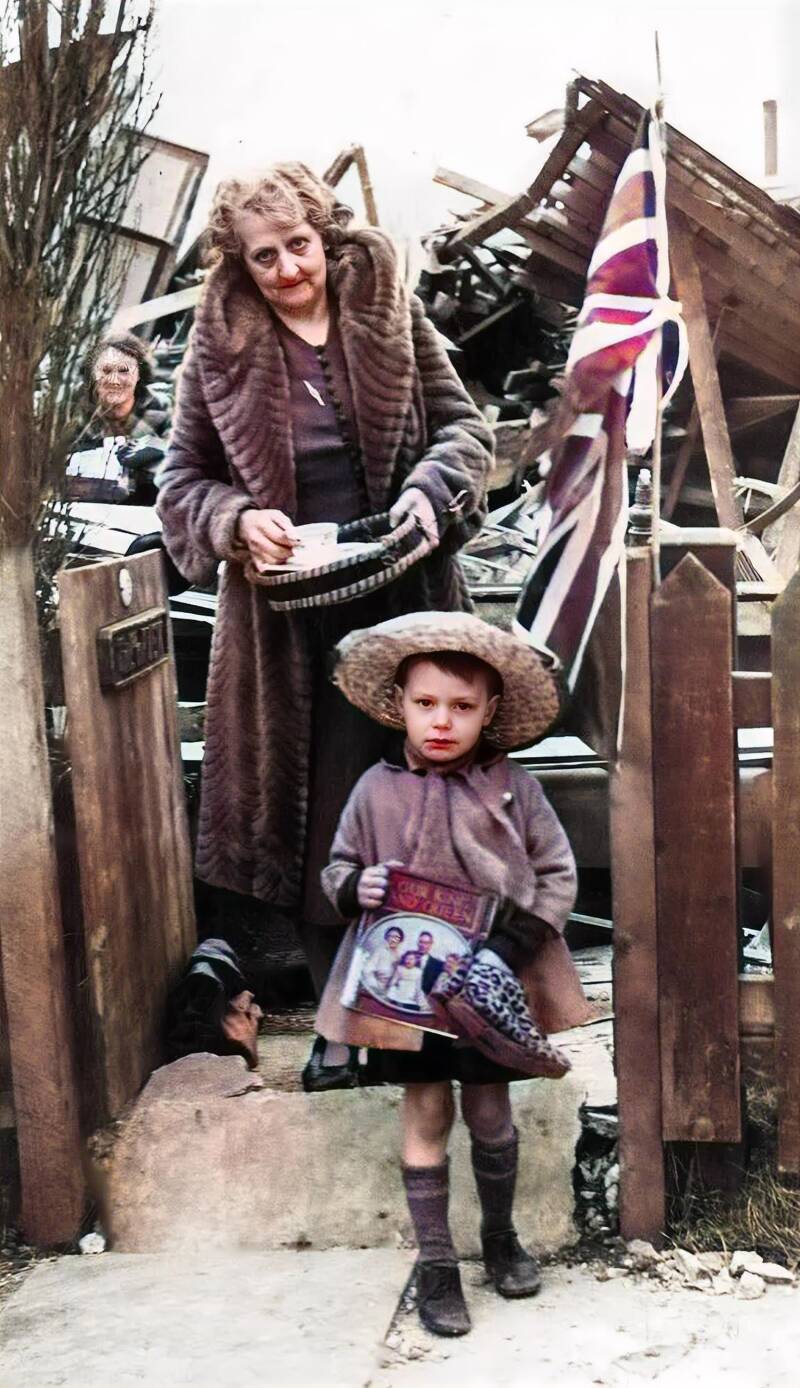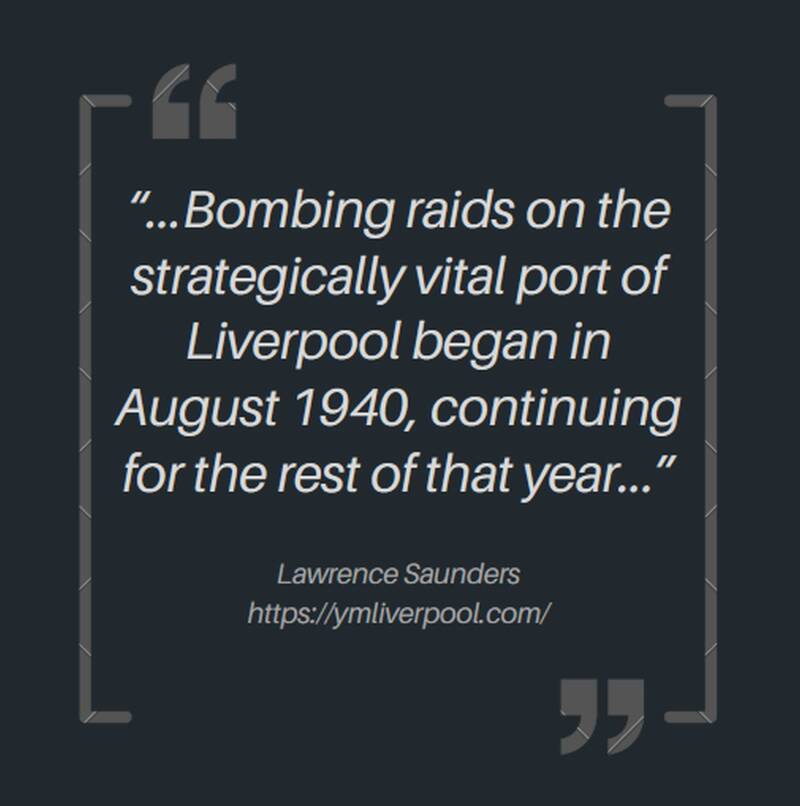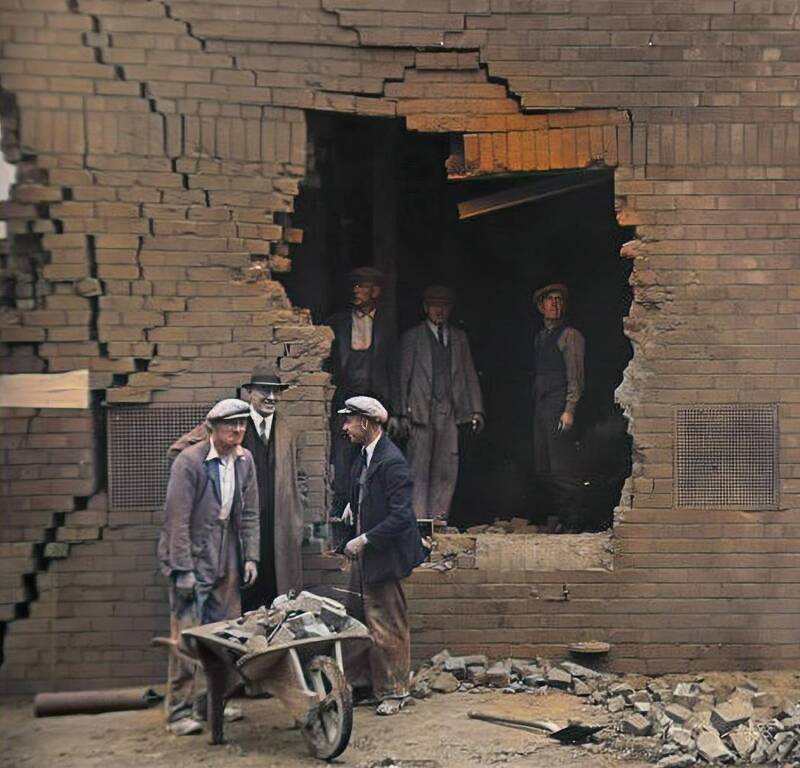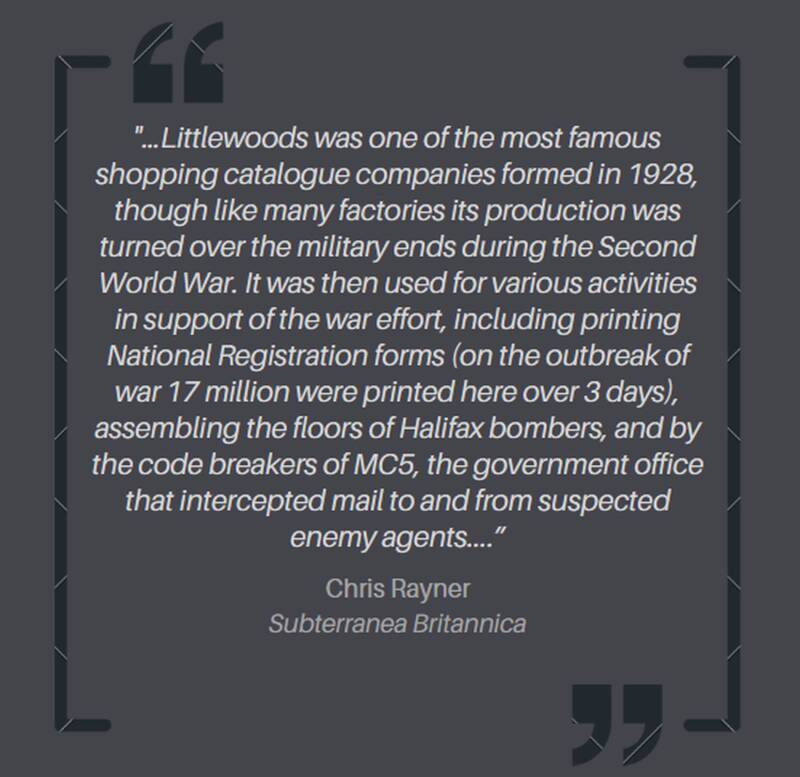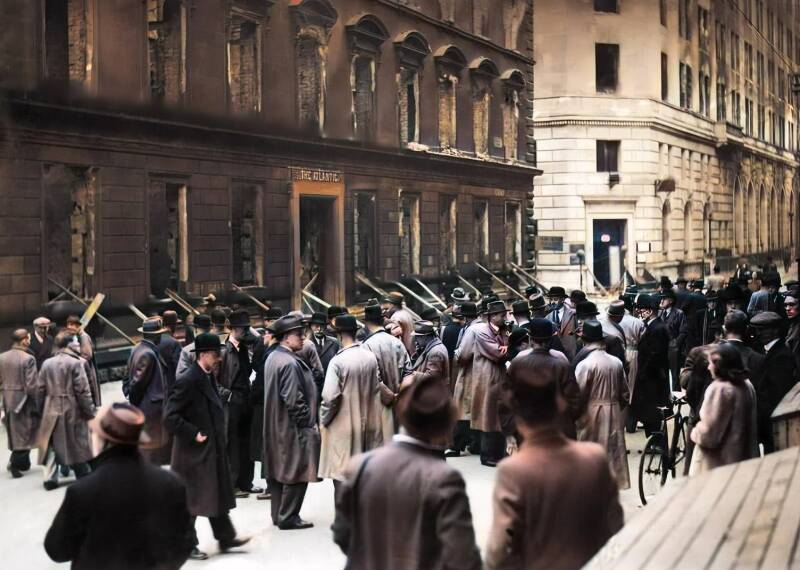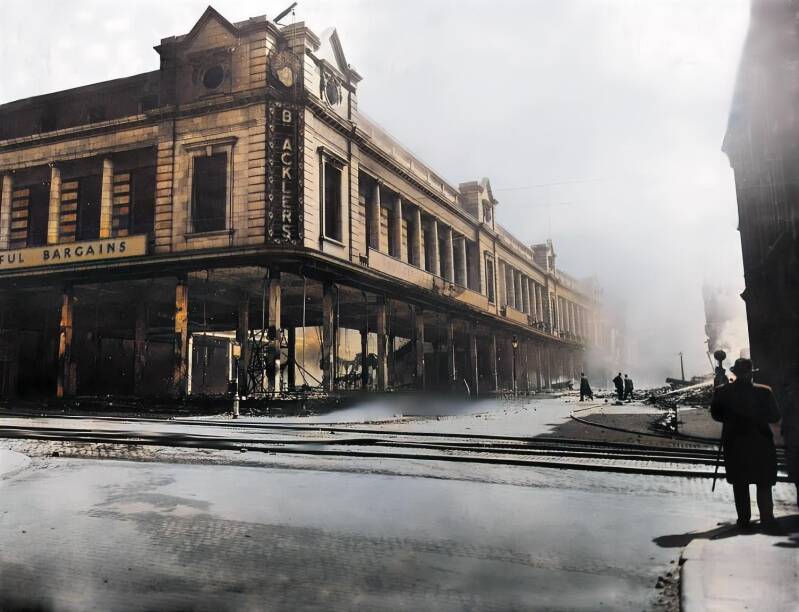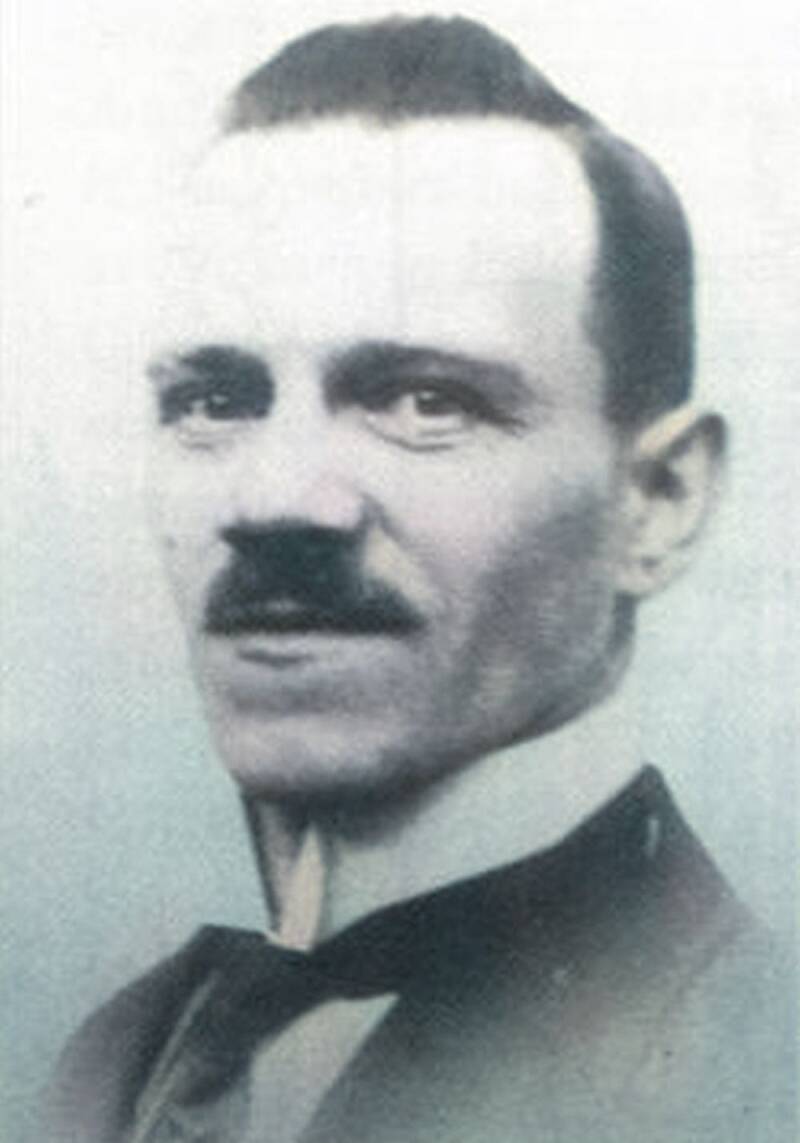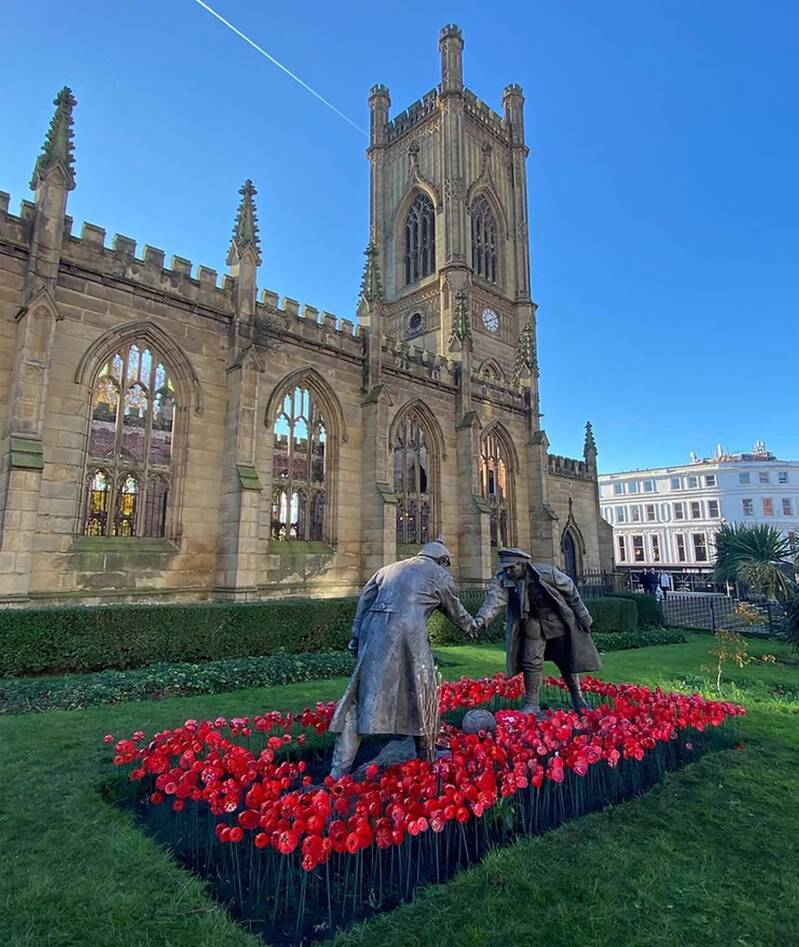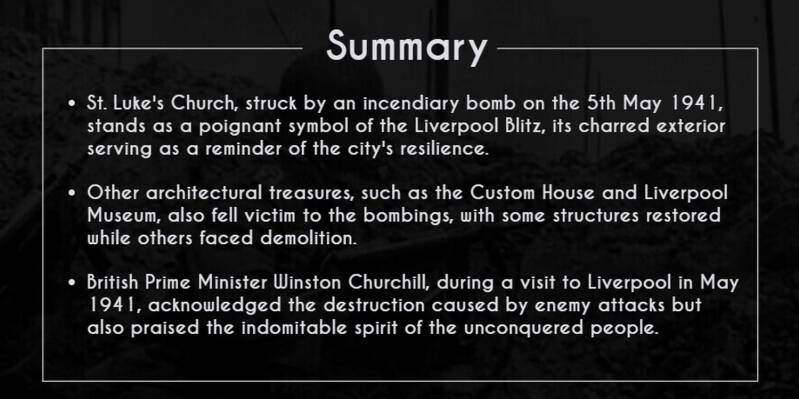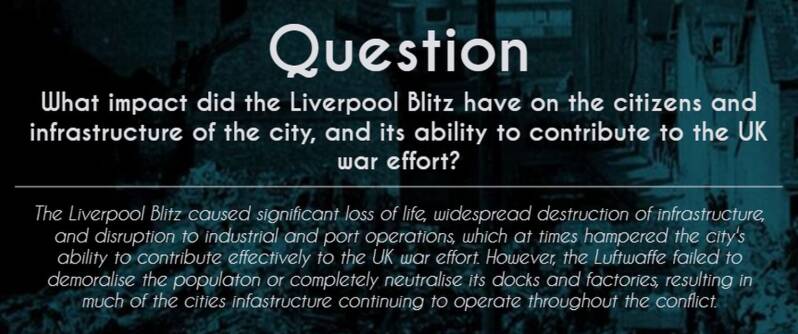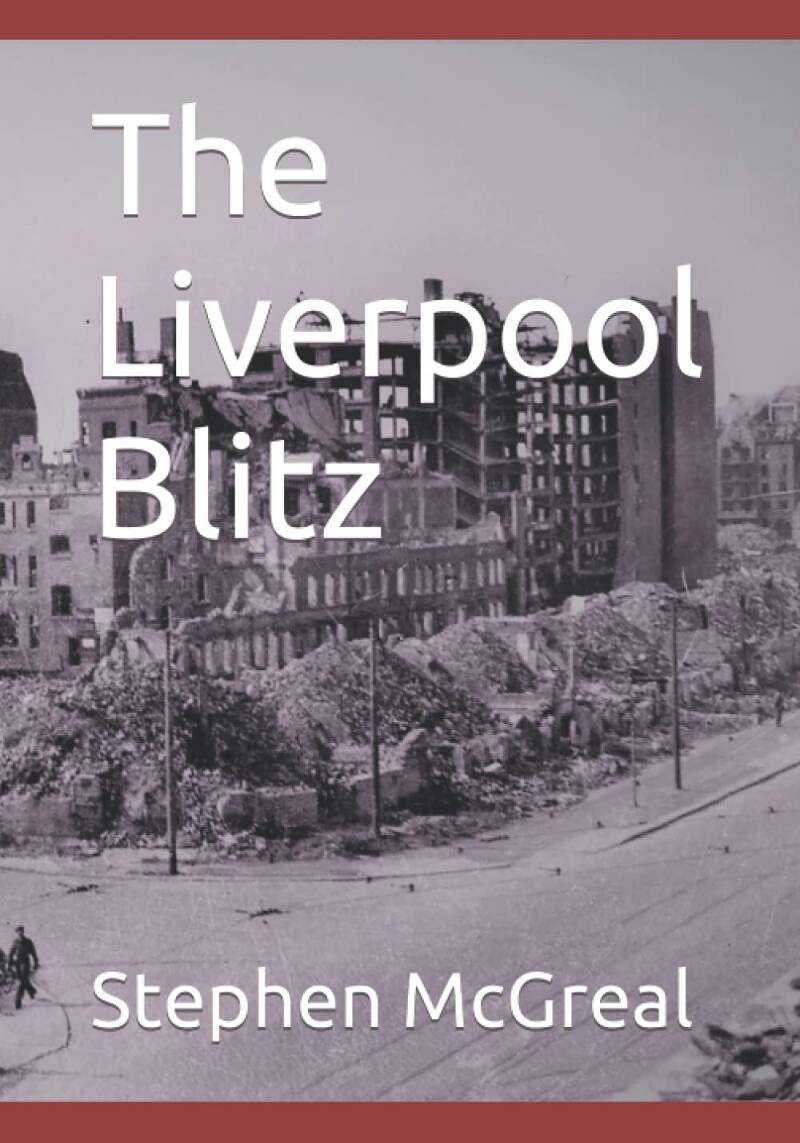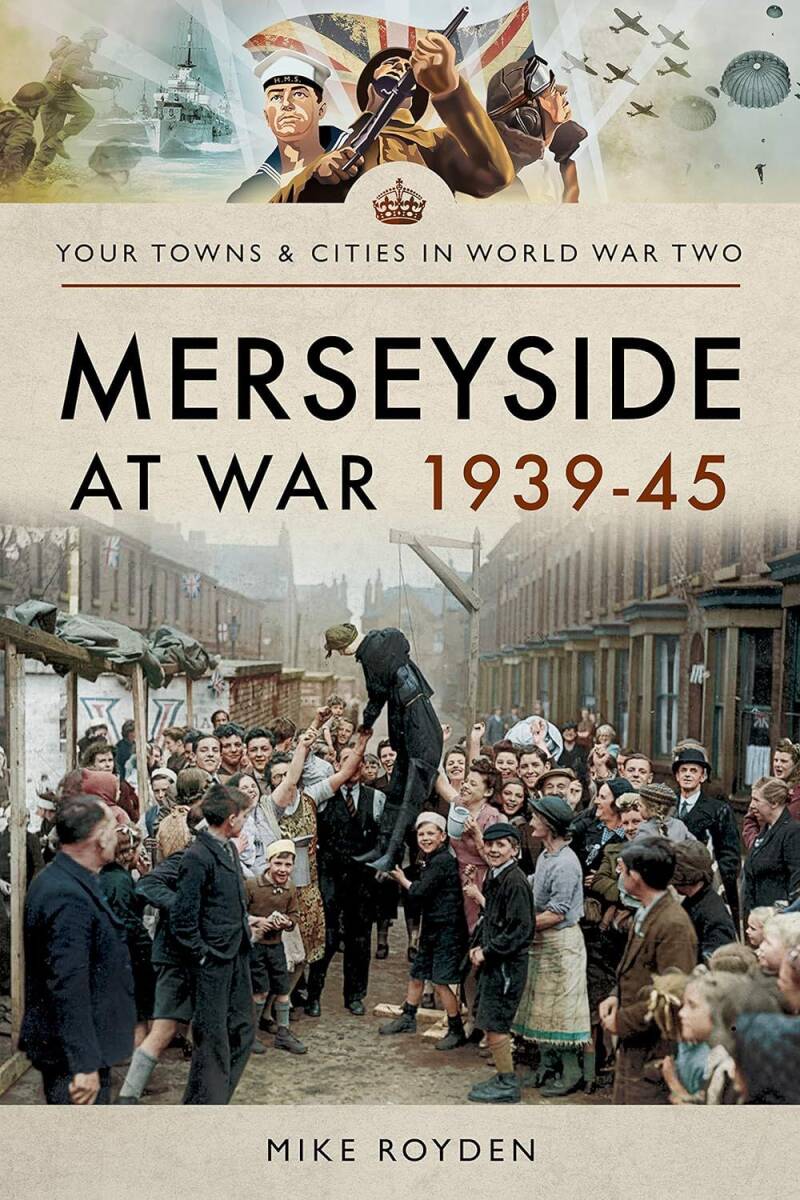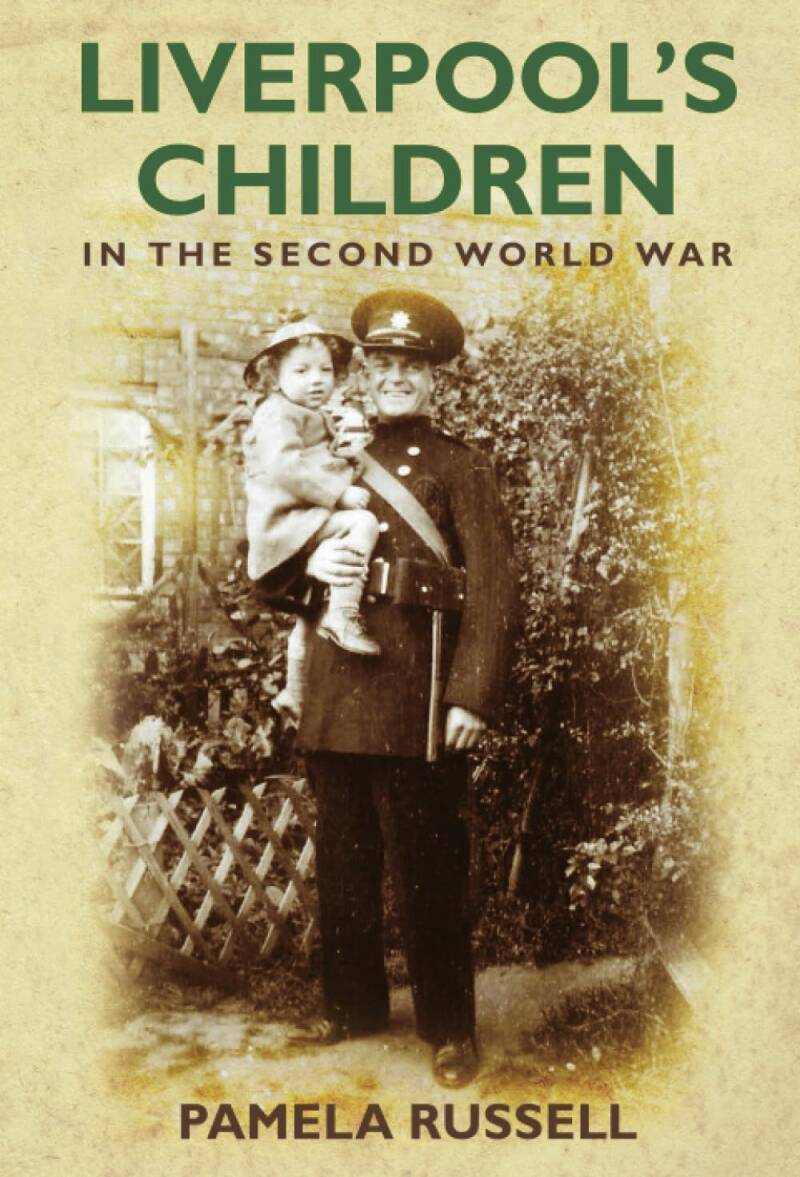Targeting Liverpool
Bombing the northern docklands
During the Second World War, the city of Liverpool and its surrounding region endured a relentless and devastating bombing campaign known as the Liverpool Blitz, carried out by the German Luftwaffe.
Liverpool, alongside Birkenhead, possessed the largest port on the west coast of England, making it a vital component of the British war effort.
Consequently, it became the most heavily bombed area in the country, apart from London.
Unloading goods at Liverpool Docks, 5 December 1938.
The Liverpool Blitz lasted from August 1940 to January 1942, with raids occurring periodically throughout this period. The first major raid, known as the "May Blitz," took place in May 1941 and lasted for seven nights, during which Liverpool suffered continuous bombardment, causing widespread destruction and loss of life.
The city's strategic importance as a major port and industrial center made it a prime target for German bombing raids aimed at disrupting Britain's maritime trade and industrial production.
Lewis's department store in Liverpool, after it had been badly damaged during the 1941 May Blitz.
Liverpool Blitz 80 years on: harrowing images capture devastation across our city - Liverpool Echo
Details about the extent of the damage inflicted were intentionally kept vague to prevent the Germans from gaining valuable information.
Moreover, the newspapers downplayed the destruction for propaganda purposes, focusing instead on boosting morale and highlighting acts of heroism and resilience.
This approach left many Liverpudlians feeling that their suffering was overshadowed compared to other places.
County Road Walton during the Blitz.
Liverpool May Blitz 1941: Map of where the bombs landed and what damage they did - Liverpool Echo
Tragically, approximately 4,000 individuals lost their lives in the Merseyside area during the Blitz, making it the second-highest death toll in the UK after London, which suffered over 40,000 casualties by the war's end.
The bombing raids not only caused immense loss of life but also resulted in widespread damage to homes, businesses, and infrastructure, leaving large parts of the city in ruins and displacing thousands of residents.
The psychological impact of the Blitz on the people of Liverpool was profound, with many enduring trauma and hardship long after the war ended.
This view across Liverpool shows much of the damage caused by the bombing raids.
Dean and Chapter Liverpool Cathedral
A rich history
Liverpool, located in northwest England, boasts a rich history that predates the Roman era. It began as a small fishing village known as "Ligpul," evolving into a bustling port by the 13th century. In 1207, King John granted Liverpool its first charter, enabling the growth of trade and commerce.
Throughout the medieval period, Liverpool remained a relatively modest port. However, by the 17th century, it had gained prominence as a critical trade hub, particularly in the transatlantic slave trade.
The port's involvement in the triangular trade made it a central player in the British Empire's economic expansion.
An old map of the Central Station area, Liverpool in 1928
Lime Street in Liverpool, 1900.
(23) Lime Street in c. 1900, Liverpool, United Kingdom : ArchitecturalRevival (reddit.com)
...shifting its focus towards manufacturing, shipbuilding, and trade...
Young mother carries her child in a shawl, Liverpool. 3rd April 1939.
The 18th century marked a significant turning point for Liverpool. Its docks were expanded, and the city became a primary point of departure for emigrants heading to the Americas.
The Slave Trade Act of 1807, followed by the Abolition of Slavery Act in 1833, transformed Liverpool's economy, shifting its focus towards manufacturing, shipbuilding, and trade with the British colonies.
The 19th century brought further prosperity, as Liverpool became a hub for cotton trading and manufacturing. Its iconic skyline, including structures like St. George's Hall and the Albert Dock, began to take shape during this period.
The opening of the Liverpool to Manchester Railway in 1830 marked a milestone in transportation history.
6 - 44 Torboch Street, Liverpool, part of the slum clearance redevelopment. photographed on the 2nd March, 1933.
52 photos that capture a very different way of life in 1930s Merseyside - Liverpool Echo
During the period spanning from 1895 to 1918, Liverpool embarked on ambitious slum clearance initiatives aimed at addressing the dire housing conditions prevalent in the city.
This comprehensive urban renewal effort led to the construction of a significant number of new homes, surpassing even those built by authorities in areas outside of London.
The primary objective behind these construction projects was to provide suitable housing for residents displaced by the demolition of their dilapidated dwellings.
However, despite the scale of these efforts, not all displaced individuals were successfully re-housed, with priority often given to those deemed capable of meeting rent obligations for the new accommodations.
Woman and child in slum housing scene, Liverpool. Circa 1935
52 photos that capture a very different way of life in 1930s Merseyside - Liverpool Echo
The occupiers of No 3 Court, Clayton Street, Liverpool, with their canary. 2nd March 1933.
As the 20th century approached, Liverpool continued to thrive as a major port city, handling goods from around the world.
By 1939, it was a bustling metropolis, poised on the brink of the Second World War, with a vibrant economy, diverse population, and a rich cultural heritage that had solidified its position as a significant British city.
Mersey Tunnel Opening , Liverpool, July 1934 by King George V and Queen Mary.
Mirrorpix
52 photos that capture a very different way of life in 1930s Merseyside - Liverpool Echo
A viable target
During the Second World War, Liverpool, Bootle, and the Wallasey Pool complex held immense strategic significance, primarily due to the Port of Liverpool's crucial role as the primary link between the United Kingdom and North America.
This strategic importance was particularly pronounced during the Battle of the Atlantic, where control over maritime supply routes played a decisive role in the outcome of the conflict.
Copied aerial photographs supplied to German bombers during WW2 locating targets in Liverpool and Runcorn. German bomber crews had copies of this aerial photo when they blitzed Liverpool and other parts of Merseyside in 1940.
The picture shows ICI Castner Kellner Works, Salt Works, and Mersey Power fronted by the Manchester Ship Canal.
...the perilous journey across the Atlantic Ocean to reach Liverpool's docks...
The Port of Liverpool served as a vital hub for transatlantic trade and military logistics. Its extensive infrastructure, including quays and docks, facilitated the handling of more than 90 percent of the war materials imported into Britain from overseas during the war.
This amounted to a staggering 75 million tons of cargo transported through its expansive 11-mile quayside, making Liverpool one of the busiest and most critical ports in the world during this period.
Beyond its role in maritime logistics, Liverpool was also the eastern terminus of a Transatlantic supply chain originating from North America. Ships laden with essential supplies, including food, fuel, weapons, and equipment, made the perilous journey across the Atlantic Ocean to reach Liverpool's docks.
Dried beans being unloaded at Liverpool Dock, 21st February 1942
From there, these supplies were distributed throughout the United Kingdom to support the war effort on the home front and overseas.
Liverpool, shown here in 1930, was a prime target for Nazi Germany because of its docks.
Hulton Archive/Getty Images
Liverpool's Crosby Beach Is a Mile of World War II Blitz Rubble - Atlas Obscura
In addition to its maritime activities, Liverpool was home to various vital industries that contributed to the war effort.
Birkenhead, located across the Mersey River, was particularly significant, with its shipyards, factories, and warehouses playing a crucial role in wartime production and supply.
These industries produced ships, aircraft, munitions, and other essential materials necessary for the British war machine to operate effectively against Axis powers.
Preparations
After the declaration of war on the 1st September 1939, Liverpool swiftly and resolutely embarked on a series of preparations to meet the challenges and threats posed by the impending conflict.
The city's strategic significance as a major port and industrial center made these preparations not only essential but urgent.
One of the first measures undertaken was the implementation of blackout procedures. Liverpool, like other cities in Britain, had to ensure that its lights didn't offer guidance to enemy bombers during night raids.
Sandbags being prepared in Liverpool August 1939.

Training for what might become an attack on the city of Liverpool. 12th January 1937. Indeed, just two years on from this picture, Liverpool would be pounded by the German Luftwaffe in The Liverpool Blitz.
Mirrorpix
52 photos that capture a very different way of life in 1930s Merseyside - Liverpool Echo
Streetlights were dimmed or turned off, and residents were required to fit blackout curtains or blinds in their homes.
Businesses and households alike adapted to the new reality of moving in darkness, guided only by the faint glow of dimmed streetlamps.
ARP Rescue party training at Dove Street, Liverpool, January 1939.
Liverpool swiftly constructed air raid shelters throughout the city. These shelters provided safety during air raids and bombings.
The Anderson shelter, an iconic semi-underground structure made from corrugated iron, was distributed to homes, while public shelters were built in parks, squares, and other open spaces.
Preparations included educating the public on how to react during air raids and the importance of having gas masks readily available.
Liberator Bombers arriving in Liverpool Docks, 1939.
Liverpool fortified itself against aerial threats. Anti-aircraft guns were strategically placed in and around the city, ready to engage enemy aircraft. Barrage balloons were tethered to the ground to deter low-flying enemy planes.
These large balloons, anchored with steel cables, not only obstructed the flight path of bombers but also deterred them from flying at low altitudes. The skies above Liverpool and the Mersey Estuary were vigilantly guarded, as any enemy aircraft approaching the city would encounter formidable resistance.
This is the scene in Water Street, Liverpool, in 1939, 17 days after war was declared. The lines of sandbags and wire caging form part of an air raid defence system. Further down Water Street from the town hall is Derby House - the building which was later to be become famous as the combined headquarters for the Battle of the Atlantic.
The city's industrial capabilities were redirected toward the war effort. Liverpool's shipyards, renowned for their expertise, shifted their focus from luxury liners to warships and merchant vessels.
The famous Cammell Laird shipyard, for example, churned out critical warships, including battleships, aircraft carriers, and submarines.
Liverpool's factories played an equally pivotal role. They produced munitions, tanks, artillery pieces, and aircraft components.
The Ford factory in Liverpool became a hub for assembling military vehicles, while local manufacturers adapted to the production of war-related goods.
Liverpool's industrial might was harnessed to supply the armed forces and sustain the war effort.
Construction of air raid shelters in Birkenhead Park. 24th September 1938.
Mirrorpix
52 photos that capture a very different way of life in 1930s Merseyside - Liverpool Echo
An aerial view of the Three Graces and Princes Dock, alongside the River Mersey, Liverpool, in 1937. The docks and shipyards proved vital to the war effort.
Civil defense organizations sprang into action, with wardens patrolling the streets to enforce blackout regulations and assist in emergencies.
Volunteer organizations like the Women's Voluntary Service (WVS) provided crucial support, from running canteens to helping evacuate children from the city.
Liverpool's citizens united in their determination to protect their city and support the war effort.
October 1940 children aged from 18 months at the Broomgrove Children's hotel and nursing home in Wavertree, Liverpool, well accustomed to playing in their gas masks.
Pied Piper
In September 1939, as the Second World War commenced, a proactive initiative known as "Operation Pied Piper" was launched to safeguard urban and military populations from potential German aerial bombings.
During the period of September 1st to 6th, Liverpool Corporation orchestrated the evacuation of approximately 8,500 children, along with parents and teachers, from the city. These evacuees were resettled in rural areas and small towns across Lancashire, Wales, Cheshire, Shrewsbury, and Shropshire.
Liverpool children board a bus to take them to safety. 1st September 1939. Around 8,500 children were evacuated from Liverpool over six days (1st - 6th September 1939).
In the subsequent months, as the threat of Luftwaffe air raids appeared to diminish, numerous parents chose to return their children to Liverpool.
By January 1940, a remarkable 40% of the initially evacuated children had reunited with their families in the city.
This shift in circumstances reflected the evolving wartime conditions and the evolving perception of safety among the local populace.
Teachers accompany a large crowd of pupils of a liverpool inner city school to the railway station for their evacuation at the start of the Second World War on the 1st September 1939.
52 photos that capture a very different way of life in 1930s Merseyside - Liverpool Echo
Initial attacks
In August 1940, Liverpool faced its first major air raid, as 160 bombers targeted the city during the night of 28th of August.
This initial assault marked the beginning of a relentless barrage that persisted over the following three nights, becoming a grim routine for the rest of the year. In total, there were 50 raids on the city within this three-month period.
These attacks varied in scale, ranging from minor incidents involving a few aircraft that lasted mere minutes to large-scale onslaughts involving up to 300 aircraft that endured for over ten hours.
The first bombs on Liverpool. Clearing the debris at the LMS goods station in Caryl Street.
14 pictures which show how the Blitz hit Liverpool - Liverpool Echo
Air Raid Precautions workers salvaging in the debris of two working class houses bombed in a recent raid, Sidney Place, Edge Hill, Liverpool, pictured Tuesday 12th November 1940.
Mirrorpix
"The spirit of an unconquered people": How Liverpool survived the Blitz - Liverpool Echo
...port facilities, crucial for supplying the nation, were targeted...
During September 1940, Liverpool faced devastating bombardment from German bombers during the Blitz. The city's industrial zones, including factories and warehouses, suffered extensive damage.
The port facilities, crucial for supplying the nation, were targeted, leading to disruption of maritime trade. Residential areas were also heavily hit, resulting in significant loss of life and widespread destruction of homes and infrastructure.
Landmarks and cultural sites were not spared, leaving lasting scars on Liverpool's urban landscape.
...warders utilized chisels, crowbars, and sledgehammers...
On September 18th, a tragic incident unfolded as Luftwaffe bombs struck Walton Gaol, claiming the lives of 22 inmates and demolishing a wing of the prison.
Responding with urgency, police and warders utilized chisels, crowbars, and sledgehammers to free trapped prisoners buried under collapsed masonry.
...thanks to the heroics of rescue workers...
A Second World War ARP Air Raid Warden Poster. Rescue workers in Liverpool performed a vital and dangerous role and succeeded in saving many lives.
November 1940 saw more yet more strikes by the Luftwaffe causing widespread damage and loss of life. For the folks of Garston on the banks of the River Mersey however, a lucky escape occured.
For many years, the Garston Gasworks had dominated the immediate landscape, looming over the area and dominating the skyline unscathed since 1890.
However, on the 29th November, the southern part of Liverpool became a target with a typically damaging Luftwaffe raid scattering bombs across the area. The next day, a large unexploded mine was discovered near the Garston Gasworks, dangerously close to a gasholder containing 3.5 million cubic feet of gas.
Fortunately, thanks to the heroics of rescue workers, it was eventually safely disarmed. Had it exploded, it would have inflicted significant casualties, along with an immense amount of material damage being caused.
Gwladys Street School, Walton, after it had been hit in a raid in September 1940. The windows have been smashed and doors were blown out, while teachers are seen inspecting the damage to the frame, which has come apart in places. Children are also pictured standing around despite large numbers being evacuated from the city into the countryside.
Unseen police photos reveal devastation of The Blitz in Liverpool | Daily Mail Online
...working tirelessly to recover survivors trapped beneath the rubble...
However, on the same night, a disaster unfolded on Durning Road. A bomb intended for the nearby Edge Hill railway station missed its target and struck the Ernest Brown Junior Instructional College instead. The powerful explosion caused widespread destruction, resulting in the collapse of the college building.
Tragically, the basement of the college, where many sought shelter from the bombing, was crushed under the weight of the collapsed structure. The impact of the blast was exacerbated by the eruption of gas pipes and the subsequent ignition of escaping gas, further fueling the inferno.
Rescue efforts were immediately mobilized, with wardens, firefighters, and volunteers working tirelessly to recover survivors trapped beneath the rubble.
Despite the valiant efforts of the rescue teams amongst the chaos and destruction, many lives were lost and countless others forever changed.
Bomb damage on Huntley Road, Fairfield. Liverpool, 15th - 16th September 1940.
Rescue party searching amongst debris for trapped victims of a bomb dropped on a Liverpool suburban area after an extremely heavy raid on Thursday night, pictured Friday 29th November 1940.
Mirrorpix
"The spirit of an unconquered people": How Liverpool survived the Blitz - Liverpool Echo
The Christmas Blitz
In December 1940, a succession of intense raids occurred, now known as the Christmas Blitz, resulting in the tragic loss of 365 lives between December 20th and 22nd.
During these raids, air raid shelters bore the brunt of the devastation, with several direct hits causing significant casualties.
On December 20th, one such incident claimed the lives of 42 individuals when a shelter was struck, while an additional 40 perished when a bomb hit railway arches on Bentinck Street, where local residents sought refuge.
The North Liverpool docks were the target and suffered heavy bombing. The Adelphi hotel narrowly escaped a hit, but the Town Hall, Municipal Buildings, and Cunard Offices were struck, and fires ignited within them.
The Landing Stage also sustained damage. A parachute mine landed at Waterloo Dock, claiming the lives of 9 people.
An injured woman is helped to a reception centre from a First Aid Post, after her home was bombed in a Liverpool Blitz.
GREAT BRITAIN 1939 - 1945:THE HOME FRONT | Imperial War Museums (iwm.org.uk)
Destruction in Liverpool. The Luftwaffe raids caused immense damage across the city. Here, an entire building has been gutted by fire, while the buildings surrounding it have been reduced to rubble.
...a serious loss of life...
The following day, December 21st, witnessed another heartbreaking event as a shelter was hit, resulting in the loss of 74 lives.
The destruction went on as the heaviest raid to date struck Liverpool. Fires burned in many places, causing utter chaos. Canada, Gladstone, Brocklebank, Princes, Wapping, King's, and Carriers Docks were all bombed.
The Royal Infirmary was hit, causing damage to nearby houses. Other bombs struck St. George's Hall (Civil Defence workers and firefighters saved the building from any serious damage), the Electric Station at Highfield Street, Prescot Street Police Station, and the Fish Market at Hatton Garden.
Several air raid shelters were hit, resulting in a serious loss of life. Most areas to the North and South of Liverpool city center were hit, as were other parts of the city, on that night of destruction. The following day, Canada, Huskisson, and Alexandra Docks were bombed.
A gutted car storage depot in Liverpool after a raid.
14 pictures which show how the Blitz hit Liverpool - Liverpool Echo
...tirelessly battled the flames...
Amidst the relentless onslaught of the Blitz during this period, the 7th Loyals were called upon to assist in the daunting task of combating massive fires that raged relentlessly in Liverpool's Gladstone and Alexandra docks.
Throughout the Christmas Blitz, groups of 100 soldiers tirelessly battled the flames around the clock. In one particularly harrowing operation, these brave men found themselves wading through ankle-deep molten rubber, which flowed from a burning ship, adding to the perilous challenges they faced.
Merseyside Air Raid Bomb Damage 1940 Civilians and rescue workers search through the bomb damaged houses in Liverpool following a bombing raid by the Luftwaffe (The German Airforce) during the blitz.
The May Blitz
In May 1941, the region experienced a resumption of the air assault, a devastating seven-night bombardment that wreaked havoc on the city.
The initial bomb struck Seacombe in Wallasey on Wirral, occurring at 22:15 on May 1st.
The most intense phase of the bombing unfolded from May 1st to May 7th, involving a staggering 681 Luftwaffe bombers, who dropped 2,315 high-explosive bombs and 119 other explosive devices, including incendiaries. These raids incapacitated 69 out of 144 cargo berths and resulted in 2,895 casualties.
During this onslaught, Liverpool Cathedral fell victim to a high-explosive bomb, which pierced the roof of the south-east transept before being deflected by an inner brick wall and detonating mid-air, causing significant damage to numerous stained-glass windows.
Another bomb landed on the cathedral's front steps without exploding, while incendiaries ignited equipment in the contractor's yard at the western end.
Cook Street Arcade which was attacked by German bombs on the 3rd May 1941. Liverpool, Merseyside, May 1941.
May 1941 bombed out horseshoe gallery at Liverpool museum.
...resulting in a devastating explosion...
On Saturday 3rd May, a particularly noteworthy incident involved the SS Malakand, a ship carrying munitions docked at the Huskisson Dock.
The official Luftwaffe order of battle for the raid on Liverpool and Birkenhead on that Saturday, paints a chilling picture of the scale and devastation wrought upon the region.
With a total of 298 bombers assigned to Merseyside, the attack commenced at 2200hrs, unleashing a formidable payload that included 363 tonnes of high explosive and 49,706 incendiaries.
South Huskisson Branch Dock after the enormous explosion of the ammunition ship the SS Malakand in 1941.
"The spirit of an unconquered people": How Liverpool survived the Blitz - Liverpool Echo
Flying at an altitude of 1000 meters, pathfinders dropped marker flares to guide the assault, focusing their onslaught on the docks and warehouses lining the east bank of the Mersey.
The destructive impact of the raid was felt not only on land but also at sea, with casualties including the vessels Europa, Elstree Grange, a tug, and six barges.
Among the most tragic losses was the SS Malakand, a cargo liner built in 1919 and owned by the Brocklebank line, which caught fire and ultimately exploded, adding to the catastrophic toll exacted by the relentless bombardment.

Salvage attempts are under way after a massive explosion destroyed the SS Malakand and part of No.2 Dock in Liverpool in May 1941.
The Home Front: Britain 1939-45, iNostalgia Publishing/Mirrorpix
While the eventual explosion is often attributed to a burning barrage balloon, this fire was successfully extinguished. However, flames from bombed dock sheds spread to the Malakand, proving uncontrollable.
Despite the heroic efforts of the fire brigade, the fire reached the ship's cargo of 1,000 tons of bombs, resulting in a devastating explosion a few hours after the raid's conclusion.
Bomb damage in Liverpool during the Second World War. Blacklers department store on the corner of Elliot Street and Great Charlotte Street in Liverpool. Severely damaged in The Blitz of May 1941.
...some pieces of the ship's hull plating were propelled into a park...
The ruins of the organ in Wallasey Town Hall, which was damaged by a bomb during an air raid on 31st August 1940. Happily, no one was injured.
14 pictures which show how the Blitz hit Liverpool - Liverpool Echo
The Huskisson No. 2 dock and surrounding quays were obliterated, claiming four lives. The explosion's force was so immense that some pieces of the ship's hull plating were propelled into a park over 1 mile (1.6 km) away ((landing next to Bootle General Hospital on Derby Road), with the fire burning for seventy-four hours.
As the assault neared its conclusion, Luftwaffe aircrews observed that a portion of the east bank was enveloped in an unbroken blaze, stretching approximately six kilometers in length.
Although the docks and city centre were the main targets of the May Blitz, residential areas also suffered enormous damage. Nearly one third of the houses in Liverpool were damaged or destroyed.
Worst hit was Bootle, a small town outside the city boundaries but next to the port's biggest docks.
Already heavily bombed in earlier raids, Bootle only had about 15% of its houses left after the May Blitz.
During a Merseyside bomb raid on the 12th and 13th of March 1941, the corner portion of the Engineering Laboratory of Liverpool University was severely damaged by a bomb. The Medical School and Laboratories of Pathology and Physiology were also severely damaged, roofs being demolished. The only people on duty were the members of the AFS and fire fighting services and no one was hurt with the exception of a night watchman who was slightly cut by flying glass.
IN PICTURES: Merseyside during the World War 2 Blitz - Liverpool Echo
...the inferno raged on...
In the early hours of 6th May 6th, shortly after midnight, St. Luke's Church in Liverpool suffered a devastating blow when it was hit by an incendiary bomb, igniting a fierce fire that rapidly engulfed the entire building.
Built between 1811 and 1832, stood at the corner of Berry Street and Leece Street, at the top of Bold Street.
As the inferno raged on, consuming everything in its path, the clock tower, a prominent feature of the church, succumbed to the flames, with several of its bells crashing to the ground below by approximately 3:36 AM, marking the cessation of time within the burning structure.
While the church's sturdy masonry shell managed to withstand the onslaught, the interior and roof structure were ravaged beyond recognition, leaving behind a haunting silhouette of a once-proud place of worship.
The burnt out interior of St Luke's Church.
Strand Street and James Street, city centre. 3rd - 4th May 1941
Merseyside Police
Liverpool Blitz 80 years on: harrowing images capture devastation across our city - Liverpool Echo
...casualties would have been far worse...
Over 1450 people were killed in Liverpool and 250 in Bootle. Many more were seriously injured. Casualties would have been far worse if thousands of people had not left the city and dock areas each evening, to return the next day.
- 1,453 people killed in Liverpool, 257 in Bootle, 28 in Birkenhead, 3 in Wallasey.
- 1,065 seriously injured in Liverpool, 26 in Bootle, 44 in Birkenhead, 19 in Wallasey
- 4,400 houses destroyed in Liverpool, 16,400 seriously damaged, 45,500 slightly damaged
- 51,000 people made homeless in Liverpool, 25,000 in Bootle
Bomb damage in Liverpool during the Second World War. A section of St Georges Crescent damaged by fire during the May Raids in Liverpool, 1941.
...the arduous task of debris removal from streets commenced...
The seven-night bombardment left over 6,500 homes demolished due to aerial bombing, and an additional 190,000 were damaged, rendering 70,000 people homeless. Approximately 500 roads were closed to traffic, and railways and tram lines were decimated.
Additionally, 700 water mains and 80 sewers sustained damage, along with disruptions to gas, electricity, and telephone services. Aided by 9,000 workers from outside the city and 2,700 troops, the arduous task of debris removal from streets commenced.
On the night of May 3rd and 4th alone, the fire brigade responded to 400 fires.
Rescue parties searched day and night through wreckage and rubble for victims.
14 pictures which show how the Blitz hit Liverpool - Liverpool Echo
...dozens of bodies were recovered...
The neighbouring town of Bootle to the north of the city suffered extensive damage and loss of life.
A significant incident occurred when a Co-op air raid shelter at the intersection of Ash Street and Stanley Road took a direct hit.
While the precise casualty count remains unclear, dozens of bodies were recovered and placed in a temporary mortuary, which tragically fell victim to incendiaries, consuming over 180 bodies within.
Panoramic view of the city's destruction caused by eight nights of sustained bombing after the May bombing raids.
10 photographs show how the May Blitz ravaged Liverpool 80 years ago - Liverpool Echo
Braving the Bombs
During the raids on Liverpool, rescue workers and police officers exhibited immense bravery and dedication amidst the chaos and devastation wrought by German bombing raids.
These individuals worked tirelessly to save lives, provide aid, and maintain order in the face of relentless attacks on the city.
One notable example is the actions of Sergeant Claydon during the bombing on Adlington Street. Despite the danger of collapsing buildings and escaping gas,
Claydon organized rescue efforts and led teams of police and civilians in searching for survivors trapped under debris.
Tunneling through the rubble, he rescued numerous individuals, including women, children, and elderly citizens. His perseverance and selflessness epitomized the spirit of the rescue workers during the Liverpool Blitz.
Civilians and rescue workers search through the bomb damaged houses in Liverpool following a bombing raid by the Luftwaffe, 1940.
IN PICTURES: Merseyside during the World War 2 Blitz - Liverpool Echo
...individual acts of heroism...
Similarly, Constable CRANN demonstrated remarkable courage and compassion during a heavy raid in 1941. Despite the risk of falling debris and collapsing structures, CRANN extinguished fires and assisted injured individuals, including members of the Auxiliary Fire Service.
His quick thinking and bravery saved lives and prevented further casualties amidst the chaos of the bombing.
Moreover, the efforts of rescue workers and police officers extended beyond individual acts of heroism to encompass coordinated and systematic responses to the devastation caused by the bombing raids.
Teams of firefighters, medical personnel, and volunteers worked together to search for survivors, provide medical assistance, and evacuate civilians from danger zones.
Their collaborative efforts under extremely challenging conditions helped mitigate the impact of the bombings and save countless lives.
A residential area after a visit from the Luftwaffe in 1940. Rescue workers can be seen searching through the rubble for survivors.
IN PICTURES: Merseyside during the World War 2 Blitz - Liverpool Echo
...exemplified courage, resilience, and compassion...
Additionally, police officers played a crucial role in maintaining order and security during the Liverpool Blitz. Despite the chaos and destruction, they worked diligently to enforce safety measures, coordinate evacuation efforts, and prevent looting and other forms of civil unrest.
Their presence and professionalism provided reassurance to civilians amidst the uncertainty and danger of the bombing raids.
Overall, the actions of rescue workers and police officers during the Liverpool Blitz exemplified courage, resilience, and compassion in the face of adversity.
Their selfless dedication to saving lives and protecting the community remains a testament to the heroism of those who served on the front lines during one of the darkest chapters in Liverpool's history.
Local residents gather around the aftermath of a Luftwaffe bombing raid.
A psychological toll
The Liverpool Blitz inflicted profound and lasting effects on the civilian population, leaving an indelible mark on the city and its inhabitants.
As German bombs rained down on Liverpool from August 1940 to January 1942, civilians endured unimaginable horrors and faced extraordinary challenges.
First and foremost, the Blitz resulted in significant loss of life and widespread destruction. Entire neighborhoods were reduced to rubble, and iconic landmarks like the Liver Building and St. George's Hall were damaged.
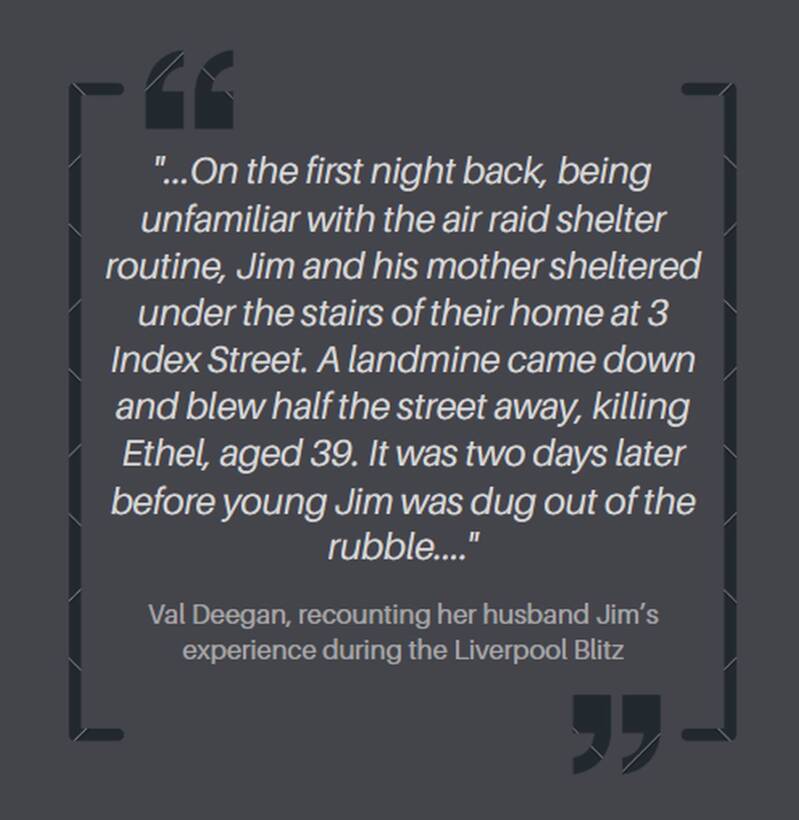
Thousands of civilians lost their lives, while many more were injured or left homeless. Families were torn apart, and communities were shattered by the relentless bombing raids.
Despite the destruction around them, local residents attempt to carry on as normal. The psychological effect of seeing your home environment being reduced to rubble can well be imagined.
...threat of sudden death or injury...
The psychological toll of the Blitz was immense. Civilians lived in constant fear of air raids, with the ominous drone of enemy aircraft overhead serving as a grim reminder of the danger lurking above.
The threat of sudden death or injury was ever-present, leading to heightened anxiety and stress among the population.
Many suffered from post-traumatic stress disorder (PTSD) and other mental health issues long after the bombing raids had ceased.
Mill Road Infirmary, Liverpool, after it is bombed during the Liverpool Blitz. The bomb landed in the courtyard at the rear of the hospital, killing many mothers and their new born babies.
10 photographs show how the May Blitz ravaged Liverpool 80 years ago - Liverpool Echo
...shortages of essential goods and long queues...
The Blitz also had a profound impact on daily life in Liverpool. Basic necessities like food, water, and shelter became scarce commodities as resources were diverted to support the war effort.
Rationing measures were implemented, leading to shortages of essential goods and long queues at food distribution centers.
The blackout, enforced to thwart enemy bombers, plunged the city into darkness at night, further adding to the sense of isolation and vulnerability felt by civilians.
The aftermath of a Luftwaffe raid on Liverpool. The sombre expression on these residents faces reflects the reality of being caught up in the Luftwaffe bombings. While undoubtedly lucky to have escaped unhurt, they would still have faced the prospect of being made homeless, the loss of their possessions and the general disruption to their life that such an event would cause.
...acts of bravery and selflessness were commonplace...
Despite the immense challenges they faced, the people of Liverpool demonstrated remarkable resilience and solidarity in the face of adversity. Communities rallied together to support one another, sharing whatever resources they had and offering assistance to those in need.
Acts of bravery and selflessness were commonplace, as ordinary citizens risked their lives to rescue survivors and aid the wounded.
A little boy stands outside the shambles of his bombed home in Liverpool in 1941. In his hands, he holds a photograph of the Royal Family.
IN PICTURES: Merseyside during the World War 2 Blitz - Liverpool Echo
Shep, the old dog standing outside the door of his home after it had been demolished by a high explosive bomb on the 25th October 1940, during relentless raids on Merseyside. Fortunately, as the house was unoccupied at the time, no one was injured.
IN PICTURES: Merseyside during the World War 2 Blitz - Liverpool Echo
A blow to industry
The Liverpool Blitz had a devastating impact on the city's industry, manufacturing, commercial sectors, and docks, disrupting operations and causing widespread destruction.
The bombing raids targeted key industrial areas and port facilities along the River Mersey, crippling the city's economic infrastructure.
One significant incident occurred on the 14th March 1941, when German bombers attacked the Liverpool Docks, causing extensive damage to warehouses, shipping facilities, and cargo vessels.
Liverppol civilians walking under damaged power lines after the blitz.
IN PICTURES: Merseyside during the World War 2 Blitz - Liverpool Echo
...severely hampering the flow of goods...
The bombing raids disrupted maritime trade and logistics, severely hampering the flow of goods and materials into and out of the port.
The Riverside Station, situated on the waterfront, fell victim to bombing on the evening of the 3rd May 1941.
Positioned at the Pier Head ship liner terminal, the station served as a bustling hub during both World Wars, facilitating the arrival of troop trains from various locations across the UK.
An electric power station on Lister Road, Fairfield, Liverpool after a Luftwaffe raid on September 5th 1940.
Striking new images show the devastation of the Blitz on Liverpool's suburbs | The Guide Liverpool
...production of millions of parachutes...
Industrial estates and manufacturing plants across Liverpool were also targeted, with factories producing essential war materials bearing the brunt of the attacks.
Following the outbreak of the Second World War in 1939, Littlewoods transformed a warehouse situated on Hanover Street into a production facility for parachutes.
This site was among numerous parachute factories operated by the company during the war, contributing significantly to the production of millions of parachutes, along with tens of thousands of dinghies and pontoons for the armed forces.
Unfortunately, the Hanover Street factory fell victim to bombing on the evening of 3rd May, 1941.
Business men from bombed out offices gather in the street to transact business on the 13th May 1941.
IN PICTURES: Merseyside during the World War 2 Blitz - Liverpool Echo
Buchanan's Flour Mills at East Float dock in Birkenhead, Merseyside after it was bombed during the Blitz. March 1941.
IN PICTURES: Merseyside during the World War 2 Blitz - Liverpool Echo
A bombed warehouse in Liverpool dock area. The docks were an obvious target for the Luftwaffe.
IN PICTURES: Merseyside during the World War 2 Blitz - Liverpool Echo
...the blitz also had a profound impact on the city's workforce...
The Custom House pub and Arthur R. Jones contractors located on, South John Street, in the Liverpool city centre photographed on the 11th October 1940. Luftwaffe bombers had paid a visit the night before.
Striking new images show the devastation of the Blitz on Liverpool's suburbs | The Guide Liverpool
The city's commercial district suffered significant losses as well, with shops, offices, and commercial buildings damaged or destroyed by aerial bombardment.
The destruction of commercial properties and infrastructure disrupted business operations and economic activity, leading to financial losses and widespread unemployment.
The corn exchange, built in 1808 and a hub of financial activity, was completely destroyed by German bombing in May 1941.
The blitz also had a profound impact on the city's workforce, as many workers were killed, injured, or displaced by the bombing raids.
The disruption to industrial and commercial operations forced businesses to lay off employees or relocate to safer areas, further exacerbating the economic impact of the bombings.
Blacklers department store on the corner of Elliot Street and Great Charlotte Street in Liverpool. It was severely damaged by German bombers in May 1941.
IN PICTURES: Merseyside during the World War 2 Blitz - Liverpool Echo
Bombing Hitler
Following the devastating raids in May 1941, the intensity of the German air assault on Liverpool gradually waned, as Adolf Hitler redirected his focus toward the Eastern Front and the invasion of the Soviet Union.
The final German air raid on Liverpool occurred on the 10th January 1942, resulting in the destruction of several houses on Upper Stanhope Street.
Bomb damage in Liverpool. South Castle Street, Liverpool, which was bombed in July 1941.
...led a relatively quiet life...
In a peculiar twist of fate, among the houses reduced to rubble was number 102, which had once been the residence of Alois Hitler, Jr., the half-brother of Adolf Hitler, and the place where Hitler's nephew, William Patrick Hitler, was born.
Alois Hitler Jr. led a relatively quiet life as a restaurant owner in Germany,
He distanced himself from Adolf and avoided involvement in his brother's political activities, striving for a quiet existence away from the spotlight.
Curiously, this house was never reconstructed, and the entire site was eventually cleared of housing and transformed into green space.
Alois Hitler Jr, Adolf Hitler's half-brother.
Alois Matzelberger Hitler Jr. (1882-1956) - Find a Grave Memorial
Aftermath
Today, one of the most poignant symbols of the Liverpool Blitz remains the charred exterior of St. Luke's Church, situated in the heart of the city.
This sacred edifice fell victim to an incendiary bomb on the 5th May 1941, its interior consumed by flames, yet its resolute shell stood tall. In its prominent urban location, the church served as a somber reminder of the enduring strength displayed by Liverpool and its environs during those tumultuous times.
Since 1952, St. Luke’s Bombed Out Church has held the prestigious status of an official Grade II listed building, recognized and protected by the National Heritage List for England.
Renowned for its poignant history and iconic status as a stark reminder of the devastating German bombardment during the Blitz, the church has been carefully preserved as a managed ruin, serving as a solemn memorial to the countless lives lost during that tumultuous period in Liverpool's history.
St Lukes in the present. Now a memorial to the victims of the blitz on Liverpool.
Now transformed into a memorial garden, paying homage to the countless local men, women, and children who perished in the bombings that ravaged their city and region.
Bomb damage in Liverpool during the Second World War. An emergency water supply reservoir which has been established in the basement of a blitzed building at the corner of Cook Street and Castle street, Liverpool. 20th April 1942.
...the toll of German bombs on the region...
This Church Street shop facade was left standing when bombs destroyed the building around it.
14 pictures which show how the Blitz hit Liverpool - Liverpool Echo
The Blitz also took its toll on other architectural treasures, including the Custom House, Bluecoat Chambers, and Liverpool Museum.
While some structures were lovingly restored in the post-war years, the fate of the Custom House remained contentious, leading to its eventual demolition.
During a visit to Liverpool and its surrounding areas in May 1941, British Prime Minister Winston Churchill aptly observed, "I witness the destruction wrought by enemy attacks, yet I also witness ... the indomitable spirit of an unconquered people."
When all was said and done, the toll of German bombs on the region had claimed the lives of 2,716 individuals in Liverpool, 442 in Birkenhead, 409 in Bootle, and 332 in Wallasey.

A bombed-out family removed to a new address.
14 pictures which show how the Blitz hit Liverpool - Liverpool Echo
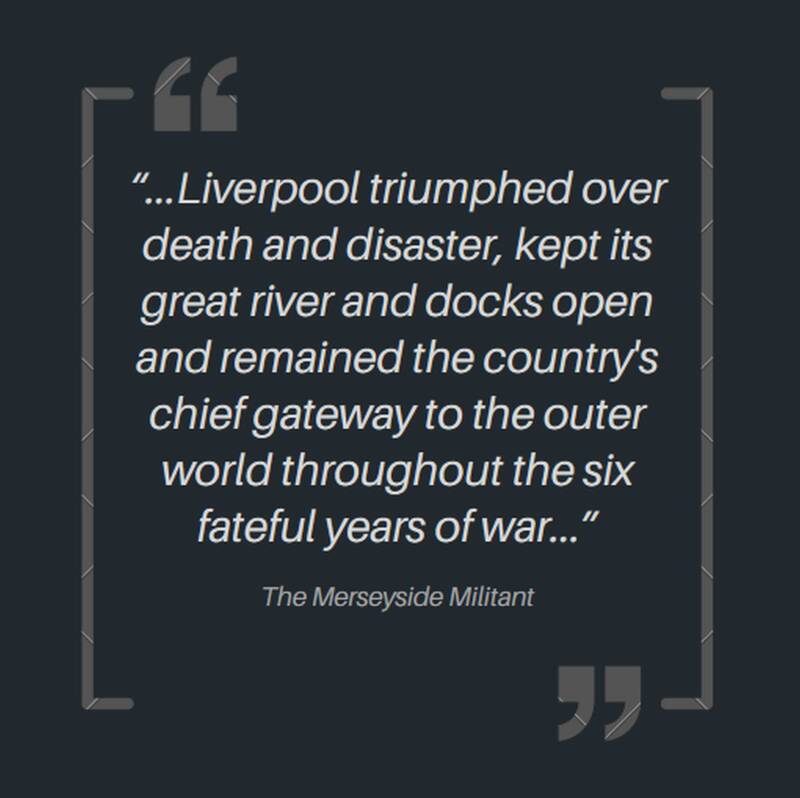
Made with Visme Infographic Maker
Further reading
Stephen McGreal's "The Liverpool Blitz" provides a gripping portrayal of the city's wartime ordeal. With meticulous detail and compelling narrative, McGreal vividly captures the devastation inflicted on Liverpool during the Blitz. Through firsthand accounts and historical analysis, he illuminates the resilience and courage of its inhabitants in the face of relentless bombing raids. A poignant and insightful read, offering valuable insights into the human experience of war and the enduring spirit of Liverpool.
Neil Holmes' "Liverpool Blitzed: Seventy Years On" offers a poignant reflection on the enduring impact of the Blitz on Liverpool. Through a combination of archival photographs and insightful commentary, Holmes brings to life the harrowing experiences of those who lived through the wartime devastation. With meticulous research and heartfelt storytelling, the book pays tribute to the resilience of the city and its people in the face of adversity. A compelling and moving account that sheds light on an important chapter in Liverpool's history.
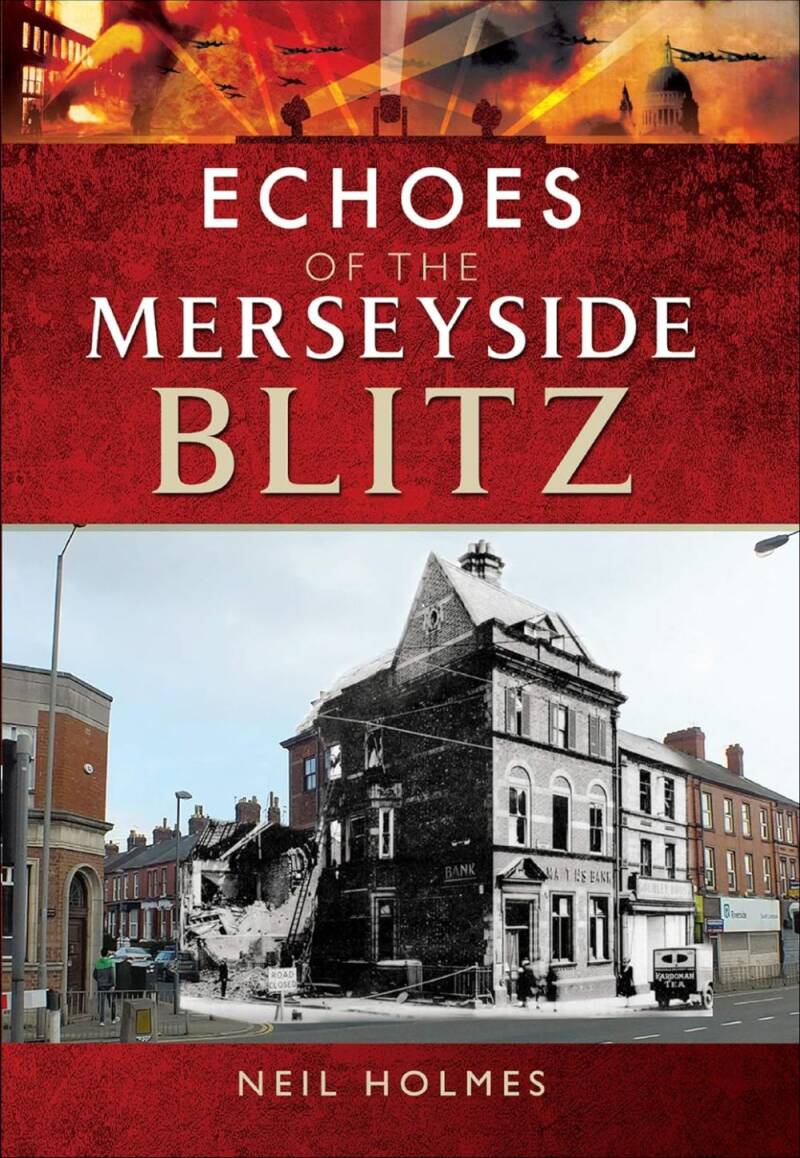
Echoes of the Merseyside Blitz" offers a comprehensive timeline of the region's wartime events, amalgamating various sources to provide insight into each night's occurrences. Neil Holmes utilizes ghost photography, merging historical wartime images with present-day counterparts, to narrate Merseyside's blitz. This technique offers a captivating glimpse into the region's past, while carefully selected photographs enrich the narrative, illustrating the enduring impact of the wartime era on Merseyside.
The book offers rare glimpses into life in war-torn Merseyside, presenting untold stories from eyewitnesses of the Blitz, the port's defense, and the challenging conditions in Huyton's prisoner of war camp. Through diverse narratives, including personal memoirs and newspaper accounts, it vividly recounts the experiences of ordinary individuals on the Home Front, showcasing their courage and resilience during the wartime trials.

Renowned historian Juliet Gardiner delivers a long-awaited exploration of the Blitz in her latest work, highlighting its profound impact on Britain. Through meticulous research, she reveals the nationwide consequences of the nightly bombings, illustrating how amidst loss and devastation, the attacks spurred a newfound national resolve. The book sheds light on the transformative effect of the Blitz, showcasing Britain's resilience in the face of the menacing Nazi threat.
Through firsthand accounts from Liverpool Blitz survivors, this book captures their experiences of adventure, danger, and resilience during wartime. Delving into the childhood memories shaped by conflict, it offers a poignant glimpse into the lasting impact of war on individuals' lives. With humor and sorrow, it illuminates the collective spirit of a city defiant against the Luftwaffe's onslaught, showcasing the indomitable resilience of those who endured the darkest hours of the bombing campaign.
Sources:
WIkipedia
https://www.liverpoolecho.co.uk/news/liverpool-news/amazing-story-statue-baby-jesus-19511565
https://uxogroundworks.com/remembering-the-past-a-history-of-the-christmas-blitz/?cn-reloaded=1
https://www.historyofliverpool.com/liverpool-blitz/
https://www.liverpoolmuseums.org.uk/stories/sharing-human-stories-behind-blitz
http://ww2talk.com/index.php?threads/20th-december-1940-liverpool-blitz.92253/
https://www.liverpoolecho.co.uk/news/nostalgia/gallery/then-now-together-liverpool-city-8683191
https://www.findagrave.com/memorial/240003803/alois-matzelberger-hitler
https://www.liverpoolecho.co.uk/news/nostalgia/14-pictures-show-how-blitz-11275718
https://www.liverpoolecho.co.uk/news/liverpool-news/the-spirit-unconquered-people-how-17455091
https://www.liverpoolecho.co.uk/news/nostalgia/gallery/second-world-war-local-evacuees-10512910
https://www.atlasobscura.com/articles/liverpool-beach-war-archaeology
https://www.liverpoolecho.co.uk/incoming/gallery/liverpool-during-second-world-war-6669821
https://www.iwm.org.uk/history/the-liverpool-blitz
Merseyside Police
https://www.liverpoolecho.co.uk/news/liverpool-news/liverpool-blitz-80-years-on-20471846
https://www.liverpoolecho.co.uk/incoming/gallery/old-liverpool-gets-splash-colour-6646805
https://www.oldtowns.co.uk/Mapshop-Liverpool-1928/Liverpool-1928-14.htm
https://www.liverpoolecho.co.uk/incoming/gallery/liverpool-during-second-world-war-6669821
https://www.liverpoolecho.co.uk/news/nostalgia/liverpool-blitz-1941-map-bombs-3364817
https://www.liverpoolecho.co.uk/news/nostalgia/liverpool-blitz-animated-map-charts-9945979
Jane Flood
https://blog.nationalarchives.gov.uk/read-about-child-evacuees-second-world-war/
https://www.thegazette.co.uk/all-notices/content/100364
https://www.liverpoolecho.co.uk/incoming/gallery/liverpool-docks-through-the-decades-7294190
https://www.iwm.org.uk/collections/item/object/205087799
https://www.liverpoolcitypolice.co.uk/roll-of-honour/edward-crann/
https://www.cultureliverpool.co.uk/liverpool-blitz-gallery/
https://www.liverpoolcitypolice.co.uk/roll-of-honour/edward-crann/
Dean and Chapter Liverpool Cathedral
https://www.cultureliverpool.co.uk/liverpool-blitz-gallery/
https://www.liverpoolmuseums.org.uk/museum-of-liverpool/blitz/may-blitz-1941
https://www.bbc.co.uk/news/uk-england-merseyside-34938886
https://historicengland.org.uk/whats-new/features/blitz-stories/liverpool-feeding-the-nation/
https://www.bbc.co.uk/history/ww2peopleswar/stories/81/a4156481.shtml
https://karsh.org/winston-churchill-in-the-crown/
https://www.liverpoolecho.co.uk/news/liverpool-news/huge-gasworks-towered-over-village-24009964
J.E.Marsh
https://www.liverpoolecho.co.uk/news/liverpool-news/how-war-time-atrocity-led-12180197
https://www.bbc.co.uk/news/uk-england-merseyside-34938886
https://www.liverpoolecho.co.uk/news/nostalgia/gallery/pictures-merseyside-during-world-war-8670226
Liverpool During The Industrial Revolution (onlyinliverpool.co.uk)
Liverpool during the Industrial Revolution - The Rocket & Rainhill Trials (historyofliverpool.com)
Liverpool May Blitz: 12 sites that were bombed and how they look now - Liverpool Echo
10 photographs show how the May Blitz ravaged Liverpool 80 years ago - Liverpool Echo
Striking new images show the devastation of the Blitz on Liverpool's suburbs | The Guide Liverpool
IN PICTURES: Merseyside during the World War 2 Blitz - Liverpool Echo
The Story | St Luke's Bombed Out Church (slboc.com)
52 photos that capture a very different way of life in 1930s Merseyside - Liverpool Echo
Mirrorpix
Chris Rayner
https://www.subbrit.org.uk/sites/littlewoods-air-raid-shelter/
Lawrence Saunders
https://ymliverpool.com/may-blitz-1941-liverpool-75-years-on/15681
The Home Front: Britain 1939-45, iNostalgia Publishing/Mirrorpix
Malcolm Pheby
